South Florida’s Everglades National Park was established in 1947 with the specific purpose to protect the region’s subtropical wetlands and extraordinary biodiversity. Especially the remarkable diversity of birds in the Everglades—and their rapidly declining numbers—was a main reason the park was created.
“During the turn of the 20th century, the number of birds plummeted under pressure from both the plume trade and the alteration of the south Florida landscape. In fact, protecting this dwindling population was a major catalyst for the establishment of the national park,” the National Park Service says.
Nowadays, Everglades National Park is one of the premier bird watching destinations in the United States, if not in the world.
It’s pretty much a guarantee that you’ll see numerous bird species when visiting the Everglades.
Yet, today’s Everglades bird populations are only a fraction of what once existed in the region. (90-95% of the original bird populations is gone, according to the National Park Service.) Restoring the historic populations of birds in the Everglades is an ongoing challenge.
That said, though, it’s hard to find an easier place to see such an incredible variety of birds than the Florida Everglades.
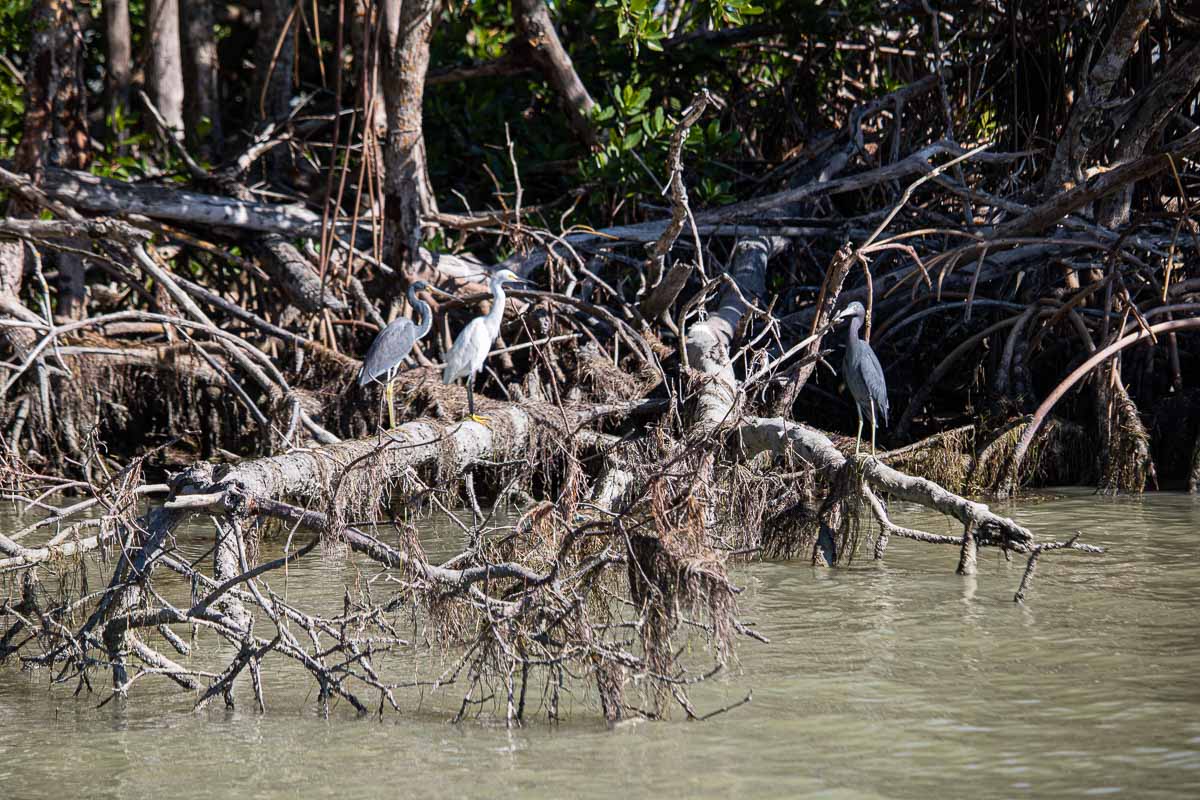
Birds are still one of the main attractions in Everglades National Park and adjacent Big Cypress National Preserve, both of which are National Park Service units.
Below, you’ll find an extensive list of more than two dozen iconic birds of the Everglades. I’ll also tell you about the best places to see birds in the Everglades.
This blog post about the birds of the Everglades contains affiliate links. You can read more about our Terms of Use / Disclosure here.
Contents
28 Famous Birds of the Florida Everglades
More than 360 species of birds have been observed in the Everglades, a number that continues to increase.
Several different “categories” of birds can be found in the region, including wading birds, water birds and waterfowl, various birds of prey, songbirds and woodland birds.
Wading Birds of the Everglades
The most famous birds of the Everglades are, without question, the wading birds. Thanks to their long legs, these birds can easily walk through and hunt in the region’s sprawling shallow waters.
Depending on the species—there are more than 15 species of wading birds in the Everglades—their diet ranges from fish and amphibians to mollusks and crustaceans.
Whether it’s along lakeshores, in ponds or canals, in sawgrass marshes or in the shallow saltwater of Florida Bay, you can see wading birds literally everywhere in the Everglades.
1. Great Egrets
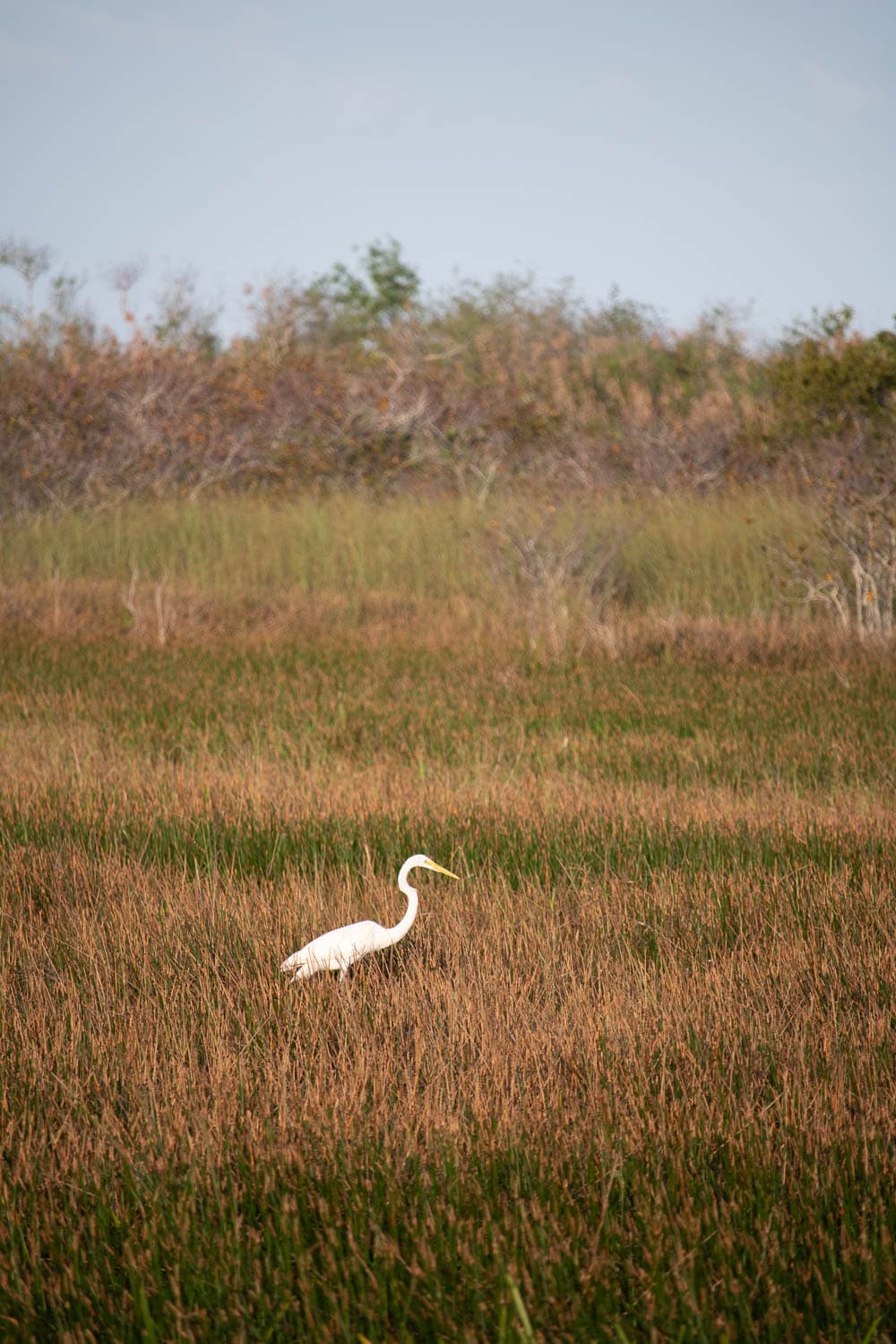
The fashion trends of the late-1800s, particularly the demand for fancy feathers, almost caused the great egret (Ardea alba) to go extinct in the United States.
Early conservationists stepped up and stopped the (illegal) hunting practices of the time, efforts that ultimately resulted in the establishment Everglades National Park in 1947.
Nowadays, great egret populations have largely made a comeback and “as a result, this bird became the symbol of the National Audubon Society,” Audubon says.
This elegant wading bird stands out because of its beautiful white feathers, long and slender neck, large yellow bill, and long black legs.
Great egrets are among the most abundant birds in the Everglades. You’ll almost certainly see one or more when spending a day exploring the Main Park Road in Everglades National Park.
Look for them in places such as the Anhinga Trail, Pa-hay-okee Overlook, Nine Mile Pond, Eco Pond, Snake Bight and Flamingo. They’re also very common in Big Cypress National Preserve.
Great egrets prefer the edges of ponds and lakes, shallow lagoons, mud flats, marshes, and rivers in wooded areas. They feed primarily on fish, but may also snatch a frog, salamander, snake or aquatic insect if the opportunity presents itself.
2. Snowy Egrets
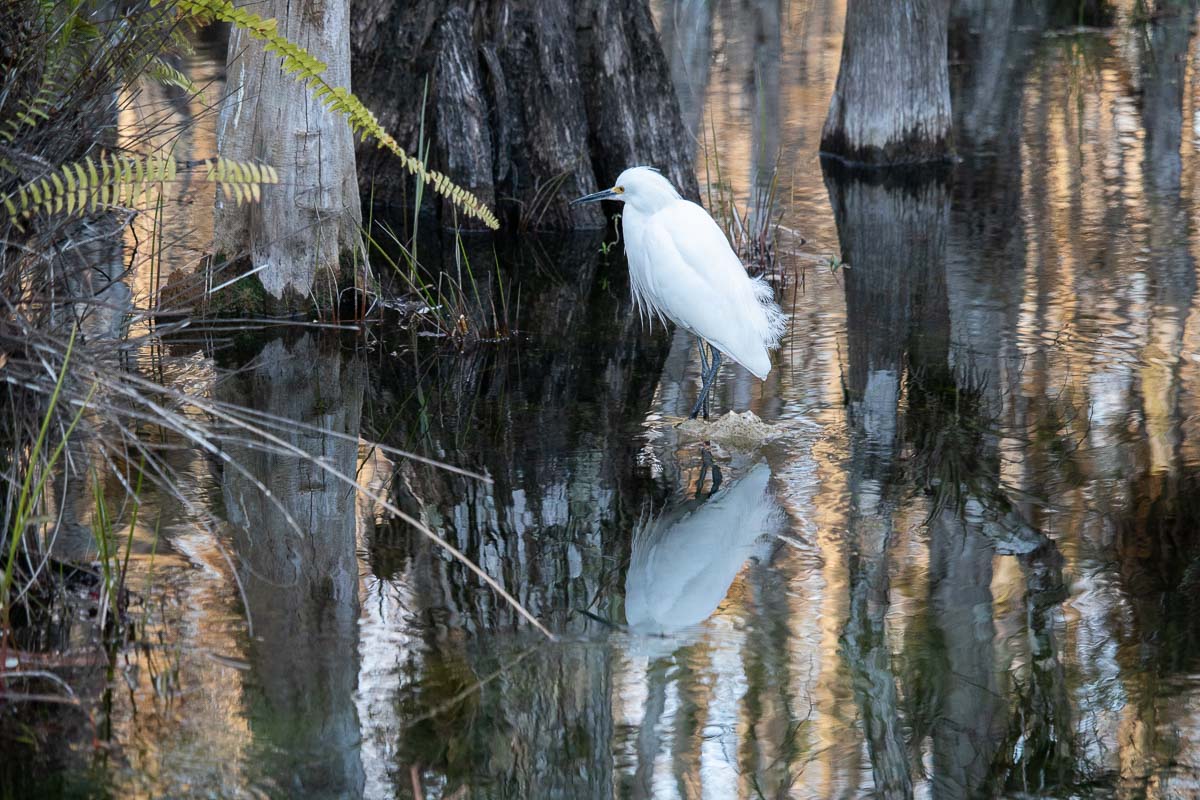
Just like the great egret, snowy egrets (Egretta thula) were popular for their white plumes in the late-19th century.
The population was decimated, but quickly recovered after protections were put in place. Nowadays, snowy egrets are as common as ever and you can see them throughout the Everglades and south Florida.
This relatively small but graceful egret species is characterized by brilliantly white feathers, a black bill, yellow face and eyes, long black legs, and large yellow feet.
It’s an industrious feeder, devouring everything from fish, frogs and crustaceans to insects, worms, rodents, lizards and snakes.
You can see snowy egrets in the Everglades in every type of aquatic habitat. This includes both freshwater and saltwater environments. Marshes, ponds, canals, shorelines, mangroves, islands,… snowy egrets are present everywhere.
3. Great Blue Herons
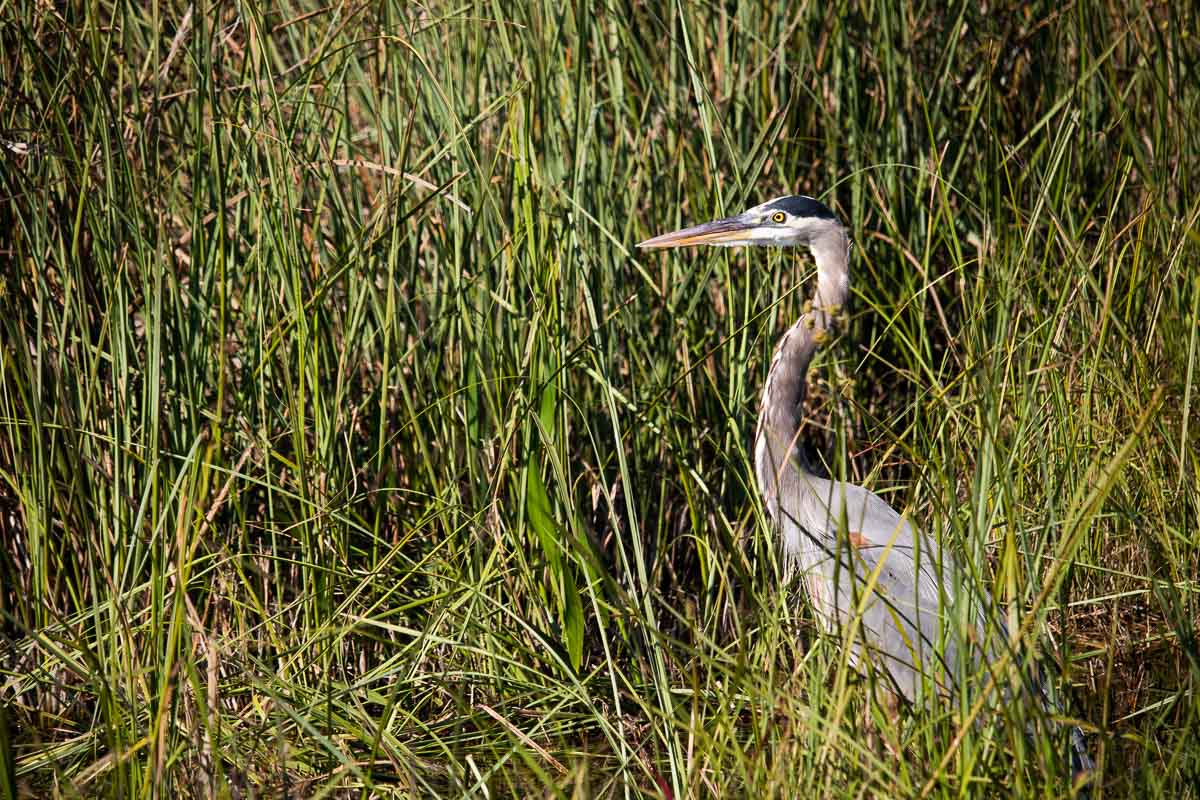
The largest heron in North America, great blue herons (Ardea herodias) is extremely common all over the continent. You’ll find them from south Florida to the Great Plains to the Southwestern deserts to coastal Alaska.
These large wading birds are often seen standing still in a quiet wetland, river or pond. This is how they forage: waiting silently or wading slowly in shallow water, striking whenever they see a fish swim nearby. They may, however, also feed on frogs, turtles, salamanders, snakes, small birds and rodents.
Great blue herons live in the Everglades all year round. You can see them all over the place, including mangrove forests, cypress swamps, sawgrass marshes, coastal prairie, small ponds, and the keys in Florida Bay.
4. Great White Herons
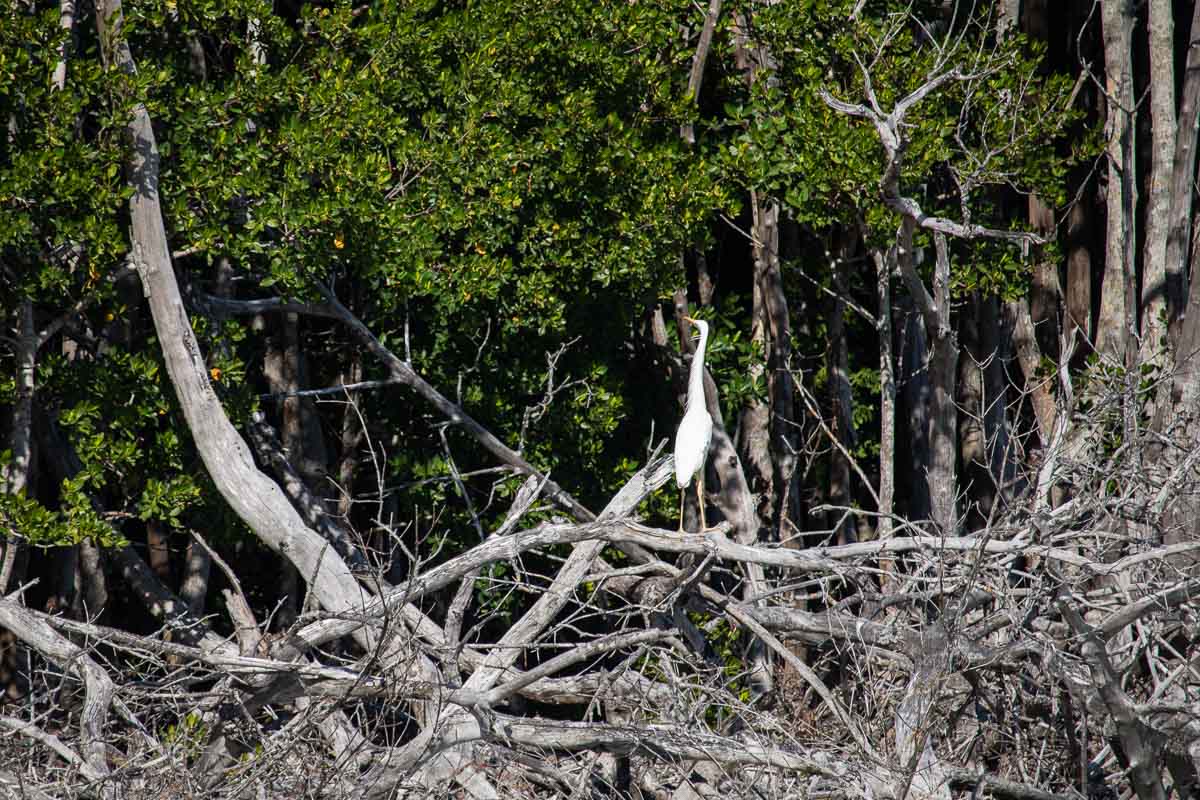
In south Florida and the Everglades, great blue herons are also present in a remarkable variation called a ‘white phase’ or ‘white morph.’
These herons are called great white herons. They’re slightly bigger than the “original” great blue herons and are completely white.
There’s an ongoing debate about whether or not great white herons are a separate species or a subspecies of the great blue heron. For now, their Latin name (Ardea herodias occidentalis) makes them a great blue heron subspecies.
Great white herons can be seen all over the Everglades. Very similar in appearance, they’re easily confused for great egrets, though.
To distinguish between great white herons and great egrets, look at their legs. Great white herons have yellowish legs, while great egrets always have black legs.
5. Little Blue Herons
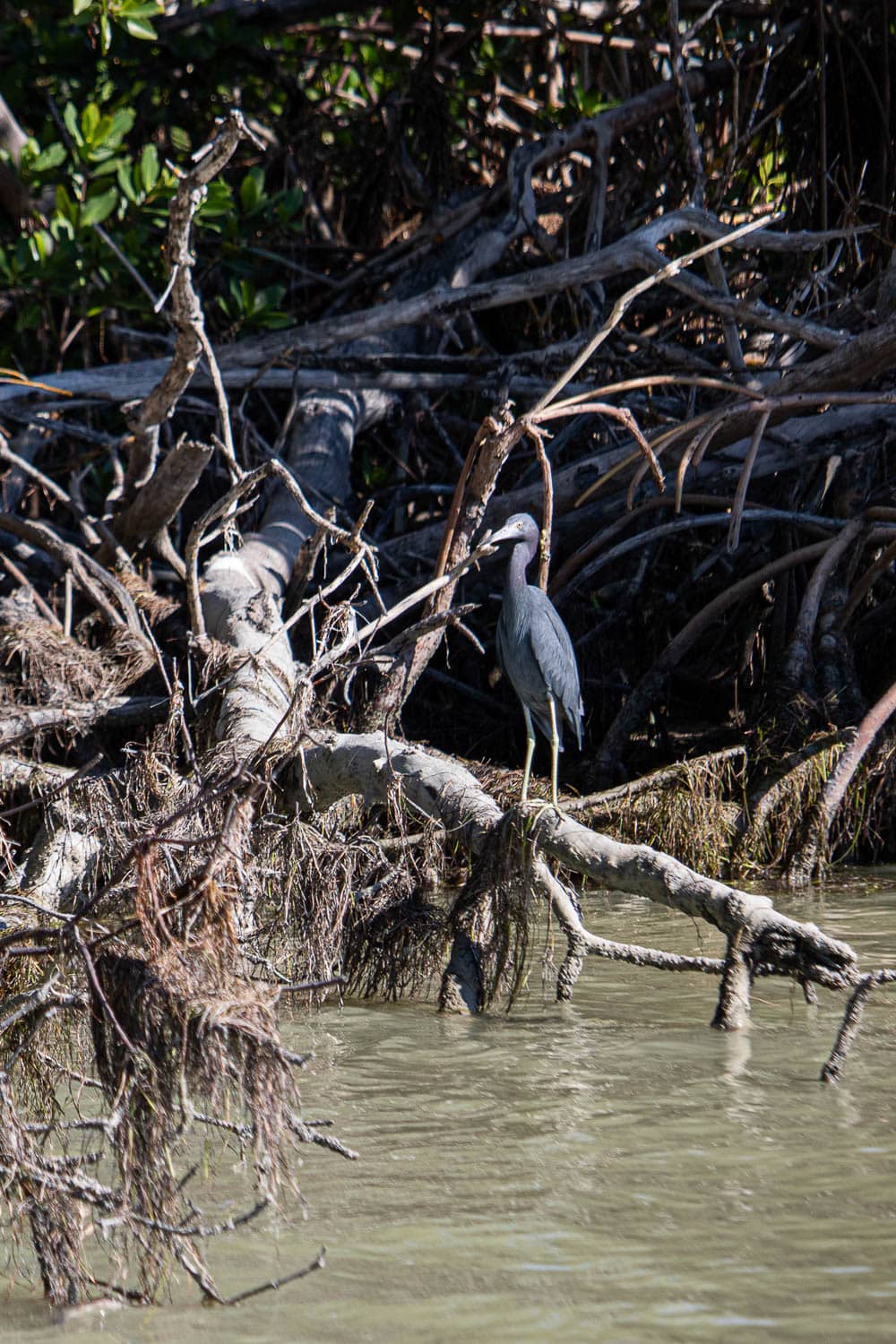
Herons and egrets are so similar they often get confused for one another. The same goes for little blue herons (Egretta caerulea), which are actually a close relative of snowy egrets.
Little blue herons have an uncanny resemblance to snowy egrets when they’re young, but develop their characteristic dark gray-blue plumes when they mature. They also have a typical blue bill with a black tip.
Fairly shy and wary, these small wading birds live around marshes, shallow lakes, ponds, wetlands, and along rivers.
Like great blue herons, they have a methodical way of hunting, typically standing silently in shallow water, or moving very slowly, patiently waiting for prey to come to them. Prey animals include mostly fish and crustaceans, but also the occasional lizard, frog, spider, small snake or turtle.
6. Tricolored Herons
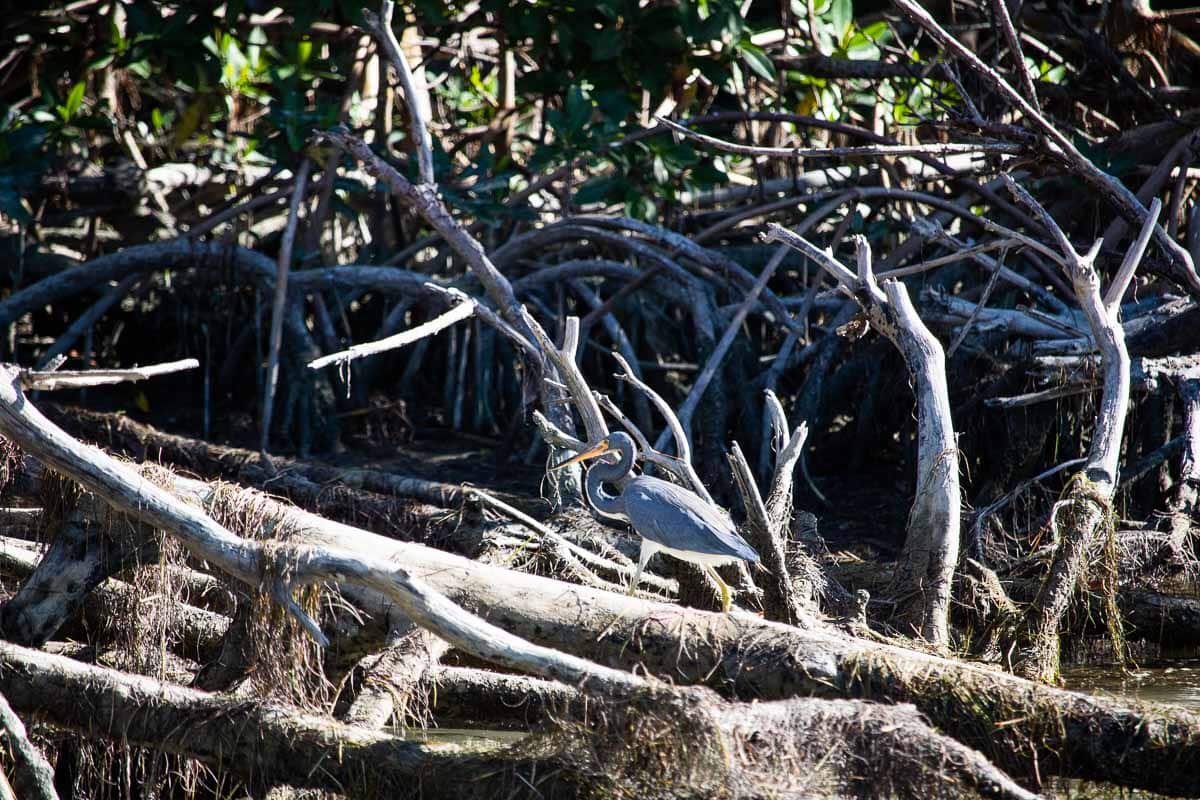
As its name implies, the tricolored heron (Egretta tricolor) is one of the more colorful species of herons in the Everglades.
The three colors referred to in its name are white, purple and blue-gray. A distinguishing feature of tricolored herons is a white stripe down the neck and a white belly.
Tricolored herons can be seen in the Everglades throughout the year, mainly in quiet and shallow waters. You might see them in marshes, mangroves and along shorelines, particularly in the Flamingo area, Florida Bay, and the rest of the southern part of Everglades National Park.
They do seem to prefer coastal lagoons, estuaries and mangrove forests, though, sometimes wading belly-deep through the water.
A social nester, you can often see tricolored herons in impressively large heron colonies—called heronries—along with other heron and egret species.
7. Green Herons
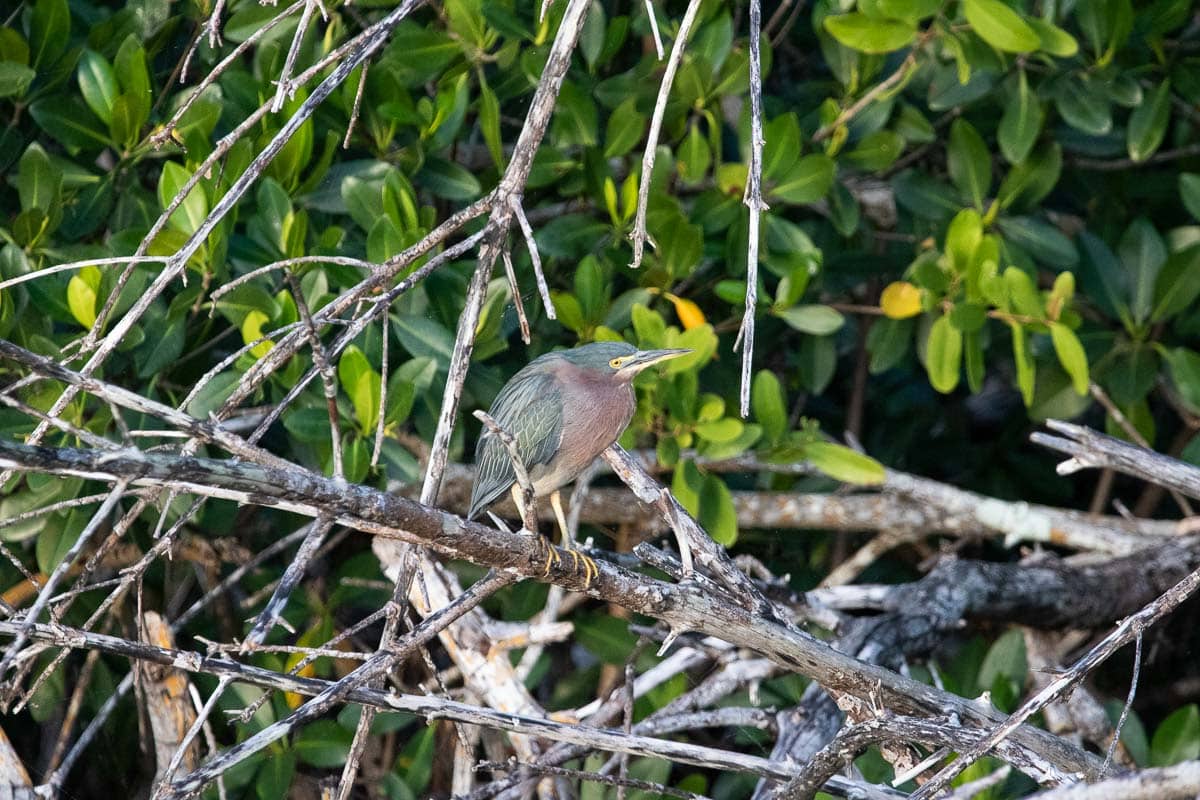
Also known as the green-backed heron, green herons (Butorides virescens) are “one of the most common herons you would encounter on a visit to the park,” the Everglades National Park website tells us.
“A relatively small wading bird, the antics of this fisherman are fun to watch. Slowly stalking in shallow water, or hanging from a low tree branch, its dart-like jab at a fish is rarely off target.”
This is a beautiful little heron with a green-blueish back and crown, and a chestnut-colored neck and breast.
Green herons live in most aquatic habitats, but prefer smaller bodies of freshwater lined with trees and shrubs, such as ponds, lakes and streams. You might also find them in coastal mangroves and cypress swamps.
In the Everglades, look for green herons at West Lake, Nine Mile Pond, Flamingo, and in Big Cypress National Preserve.
8. Black-crowned Night-Herons
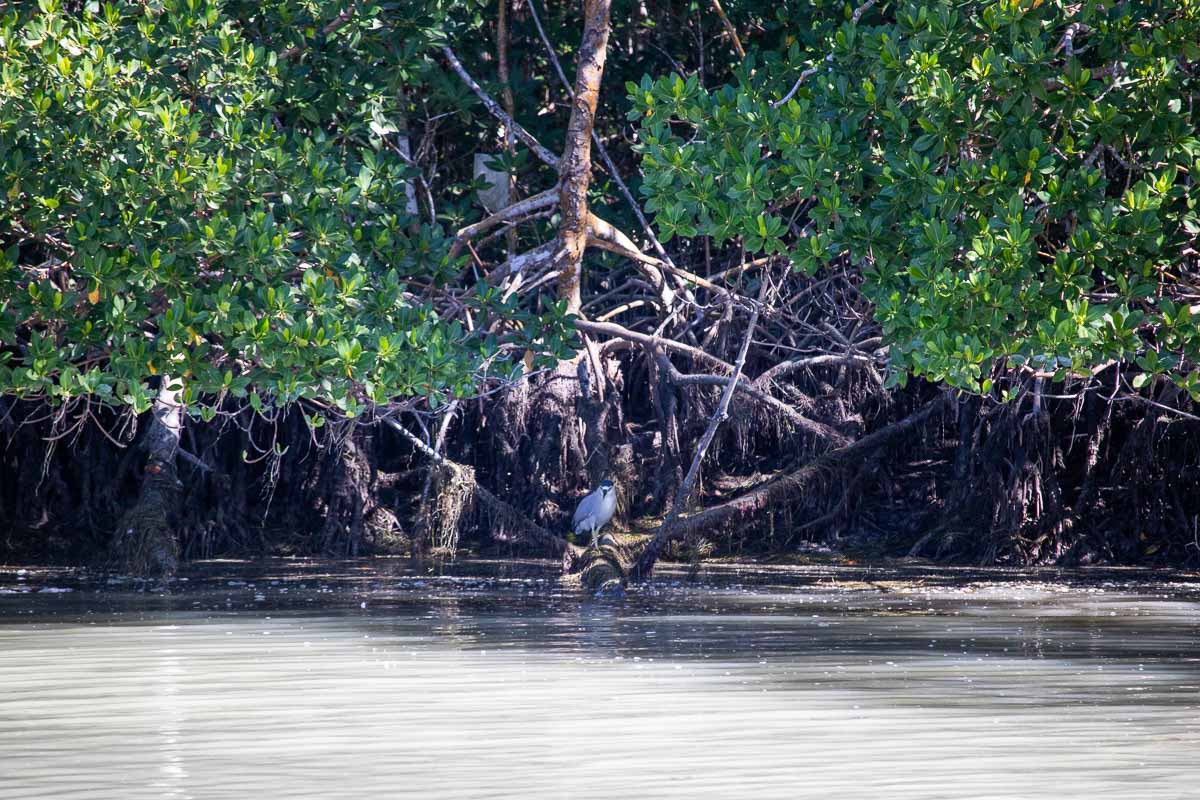
Their name describes this bird pretty well. Black-crowned night-herons (Nycticorax nycticorax) are herons that, well, have a black crown and are mostly active at night.
They’re a rather bulky and compact type of heron, quiet and concealed during most of the day, becoming more active at dusk.
Black-crowned night-herons forage in the evening and at night. They eat mostly fish, but also some insects, frogs, crustaceans, squid and even carrion, which they look for in marshes and mud flats, along shorelines and in mangroves.
According to the National Audubon Society, “some studies suggest that they feed at night because they are dominated by other herons and egrets by day.”
You can recognize adult black-crowned night-herons by their black crown and back, gray wings, pale belly and red eyes.
9. Yellow-crowned Night-Herons
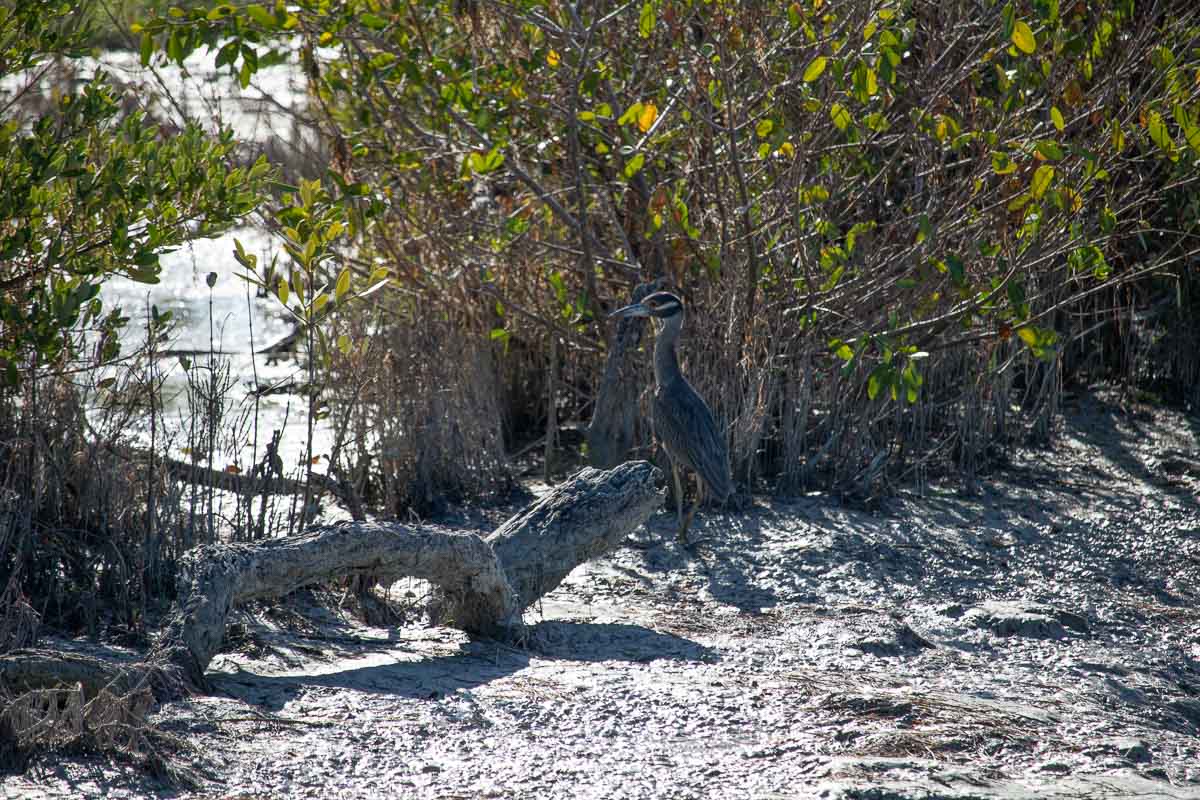
The second species of night-herons in the Everglades is the yellow-crowned night-heron (Nyctanassa violacea).
Less common and widespread than their black-crowned relatives, these small and heavy-looking herons are typically also more solitary and more difficult to find.
They feed both by day and by night, though, so you do have a chance of seeing one during bright daylight hours. For instance, I saw a yellow-crowned night-heron in the middle of the afternoon at the end of the Snake Bight Trail in Everglades National Park.
Seeing a yellow-crowned night-heron is an exciting experience. They’re absolutely beautiful birds with their characteristic face patterns—a creamy-yellow crown and head feathers, black eye patch, white cheek, and black chin.
Their eyes are piercing red, while their body is gray with black-and-white-spotted wings.
Yellow-crowned night-herons are permanents residents in south Florida and the Everglades. They live along coasts, in mangrove forests, cypress swamps, estuaries and shallow tidal waters.
Unlike most other herons, the yellow-crowns are a specialist feeder. They feed mostly on crustaceans, specifically crayfish and crabs, which they forage in coastal areas. Occasionally, they may also eat a frog, fish, mollusk or insect.
10. Roseate Spoonbills
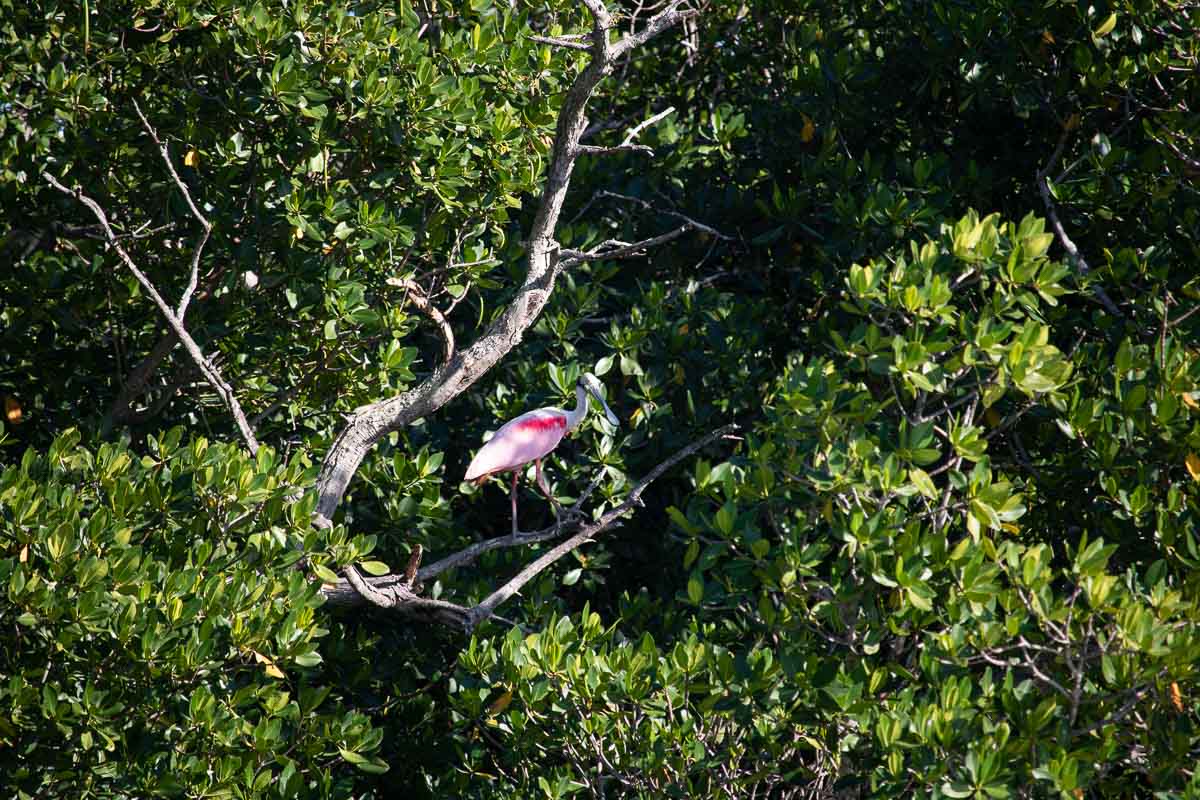
Sporting a vibrant pink plumage and characteristic spoon-shaped bill, roseate spoonbills (Platalea ajaja) are arguably the most famous birds in the Everglades.
These remarkable wading birds live along the coast of south Florida, from the Florida Keys up to Tampa. Much of this large area is protected in Everglades National Park, which comprises many miles of coastline, as well as countless keys in Florida Bay.
The best places to see roseate spoonbills in the Everglades are Sandy Key, Joe Key and Tern Key in Florida Bay. From November through March, a couple of hundred of breeding pairs nest on these small islands.
You may also see spoonbills in the Flamingo area and Snake Bight. A bit more inland, look for them in places such as Eco Pond, Nine Mile Pond and Paurotis Pond.
11. White Ibis
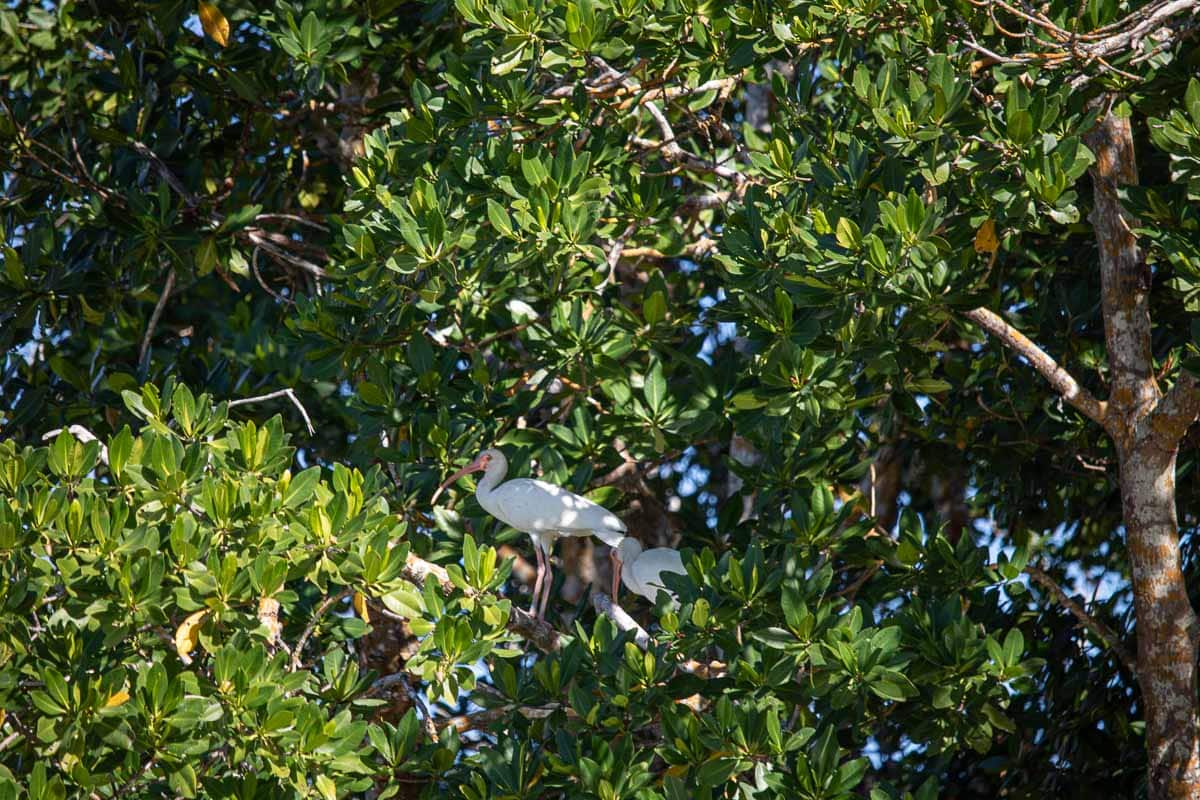
The most common wading bird in the Everglades, white ibis (Eudocimus albus) are easy to recognize by their long curved dark-orange beak.
These beautiful birds are highly social throughout every season. They feed and roost in flocks and nest together in expansive colonies. This means that when you see an ibis, there are often several others nearby.
Additionally, if you spot a group of ibis wading through the water, a bit of patience usually results in other wading bird sightings. While many other wading birds prefer fish, ibis mainly eat crayfish. As they move through the water, they stir up other prey animals, which attract other (wading) birds.
You’ll find white ibis all over the Everglades, from the cypress swamps in Big Cypress National Preserve to the estuaries and islands of Florida Bay.
12. Wood Storks
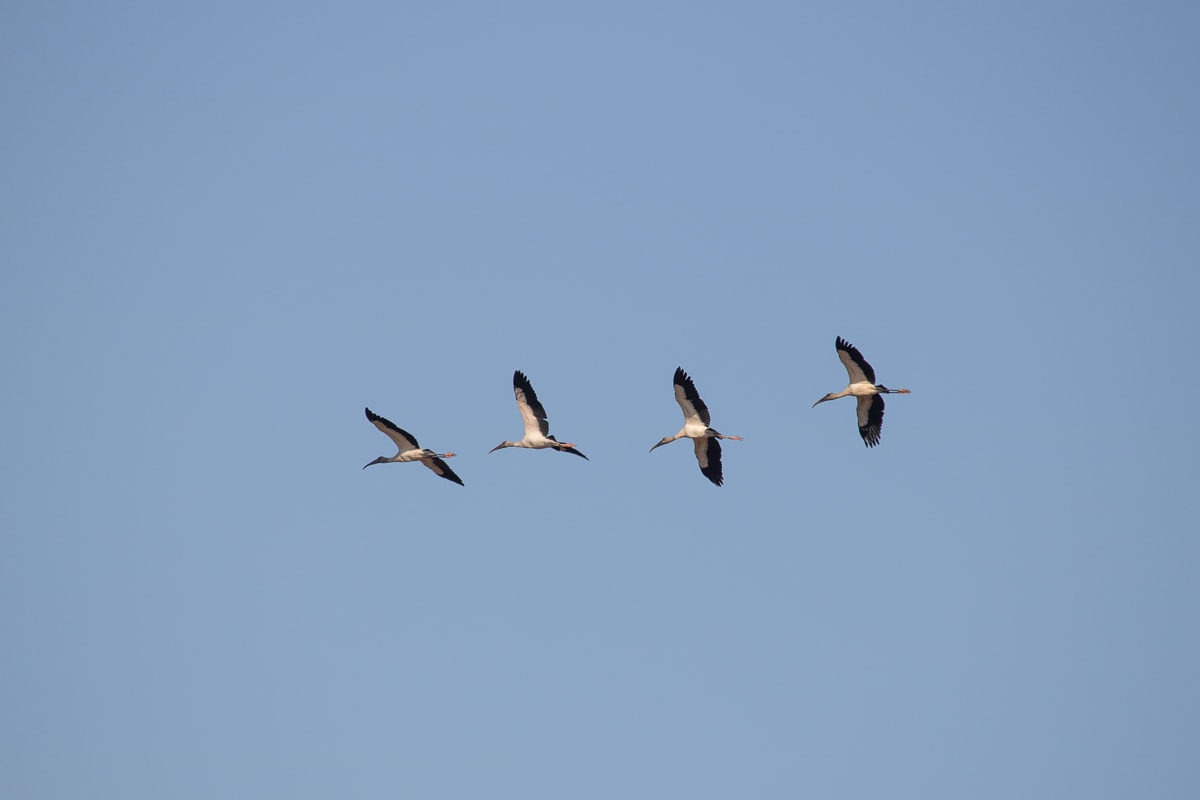
More uncommon than other wading birds like herons, egrets, spoonbills and ibis, wood storks (Mycteria americana) are always an thrilling sight.
The only native stork species in North America, wood storks live in the cypress swamps, ponds, marshes and lagoons of south Florida.
This large wading bird, characterized by its imposingly large beak and bald head, has a remarkable way of feeding.
“With its beak held in the water, the wood stork shuffles its feet. As a frightened fish swims away from its feet, it bumps into the bird’s beak. The sensitive beak can feel the fish, and it clamps down on it within a fraction of a second. Some believe this movement to be the fastest of any organism in the Everglades,” the National Park Service explains.
Even if you don’t see any storks near bodies of water, make sure to look up. The only two times I saw wood storks in the Everglades myself were two separate musters of storks flying overhead, high in the sky.
More Wading Birds of the Everglades
- American bitterns
- Reddish egrets
- Cattle egrets
- Glossy ibis
Birds of Prey of the Everglades
Compared to other bird species, birds of prey often cause the most excitement among park visitors. Soaring high in the sky, perched majestically in a tree, or actively hunting prey, this amazing category of Everglades birds never fails to impress.
Several kinds of birds of prey live in the Everglades. This includes ospreys, owls, kites, hawks and falcons, as well as eagles and vultures. Below are the most commonly seen birds of prey in the Everglades.
13. Barred Owls
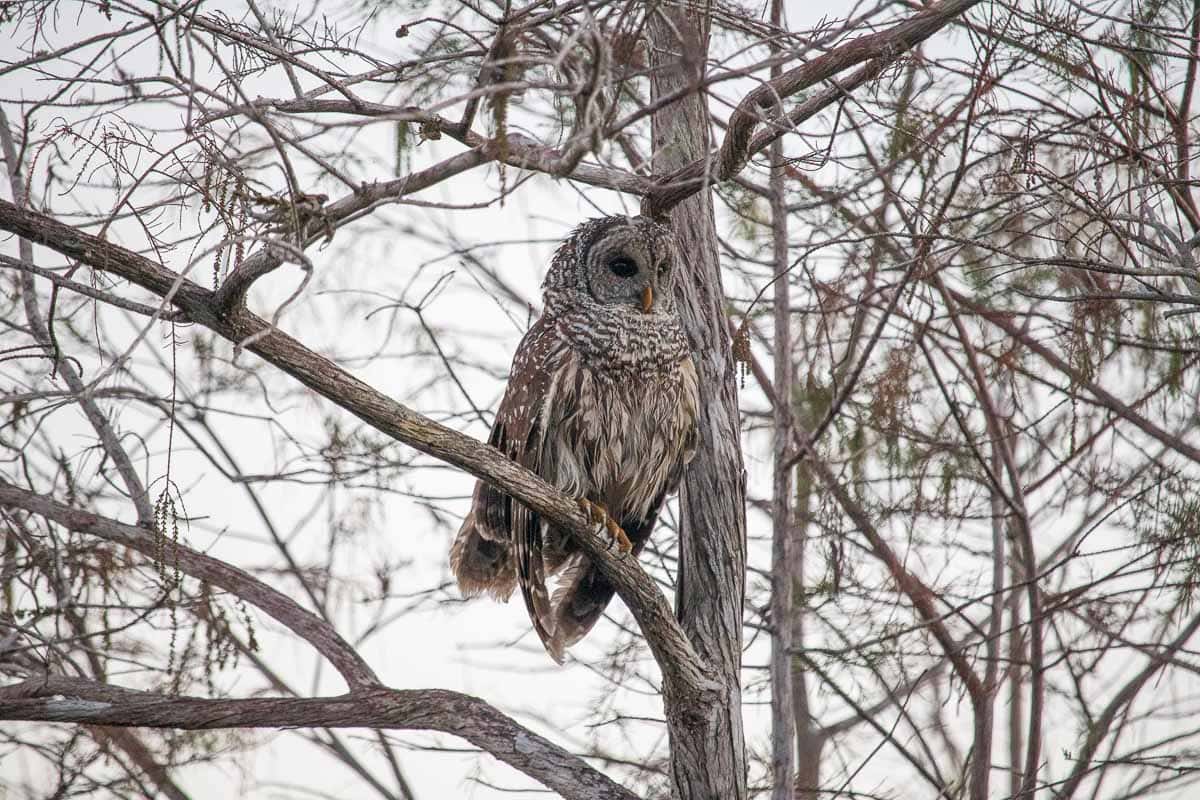
Seeing a barred owl (Strix varia) in the wild is a real treat. These large owls are mostly active at night, but early birds—pun absolutely intended—might also see or hear one around sunrise.
“The rich baritone hooting of the barred owl is a characteristic sound in southern swamps, where members of a pair often will call back and forth to each other,” the National Audubon Society says.
Your best chances of seeing a barred owl in the Everglades are in the more wooded wetland areas inland. I recommend spending some time in places like the Pa-hay-okee Overlook or Mahogany Hammock early in the morning.
You might see a barred owl sitting in a tree or, if you’re really lucky, flying low through the forest or over the wetlands.
14. Ospreys
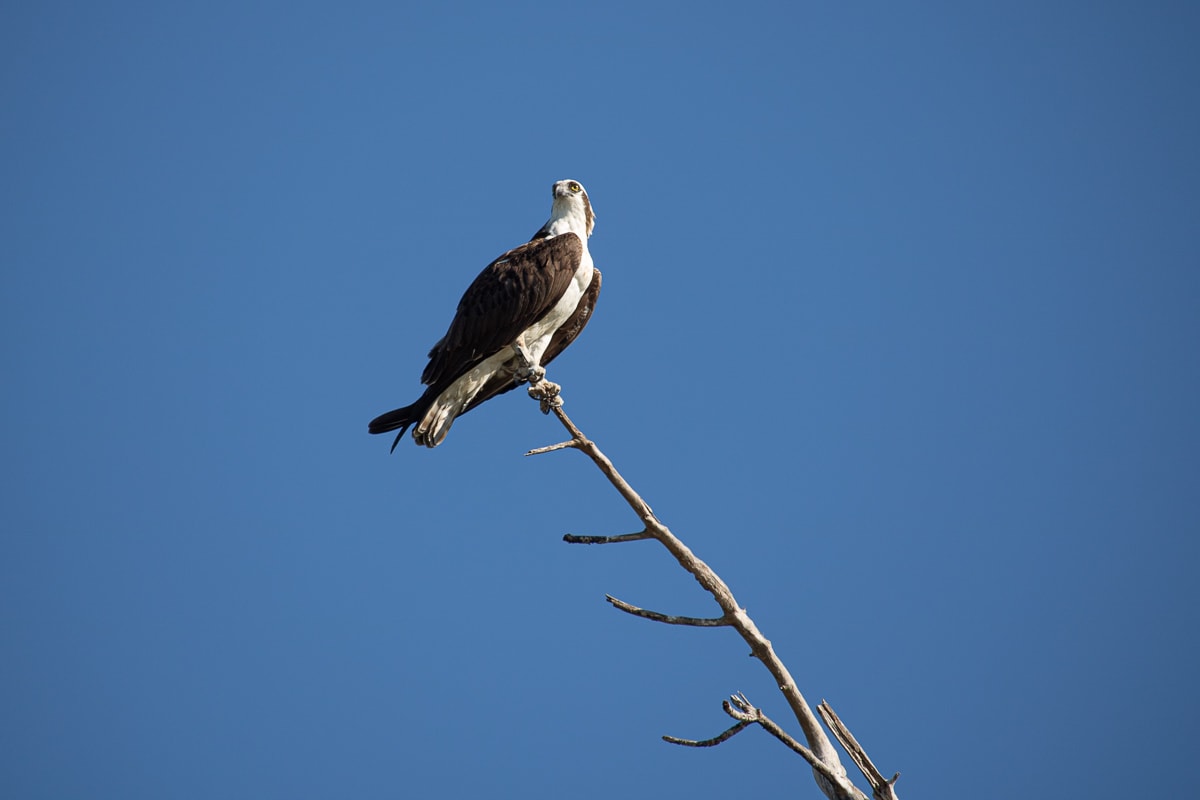
Their official name may be osprey (Pandion haliaetus), but these beautiful raptors have various other names, too, including fish hawk, river hawk and sea hawk.
All these nicknames clearly indicate where they live: near rivers, lakes and coasts, where they dine on a variety of fish.
Ospreys hunt by flying over water, grabbing fish with their talons, which is a thrilling sight to see.
They’re at home near both freshwater and saltwater, pretty much anywhere where lots of fish are present. In the Everglades, you can find ospreys throughout both Everglades National Park and Big Cypress National Preserve.
However, I recommend visiting the Flamingo Marina to optimize your chances of seeing them—they do nest in that area. A boat tour in Florida Bay also offers excellent osprey viewing opportunities.
15. Red-shouldered Hawks
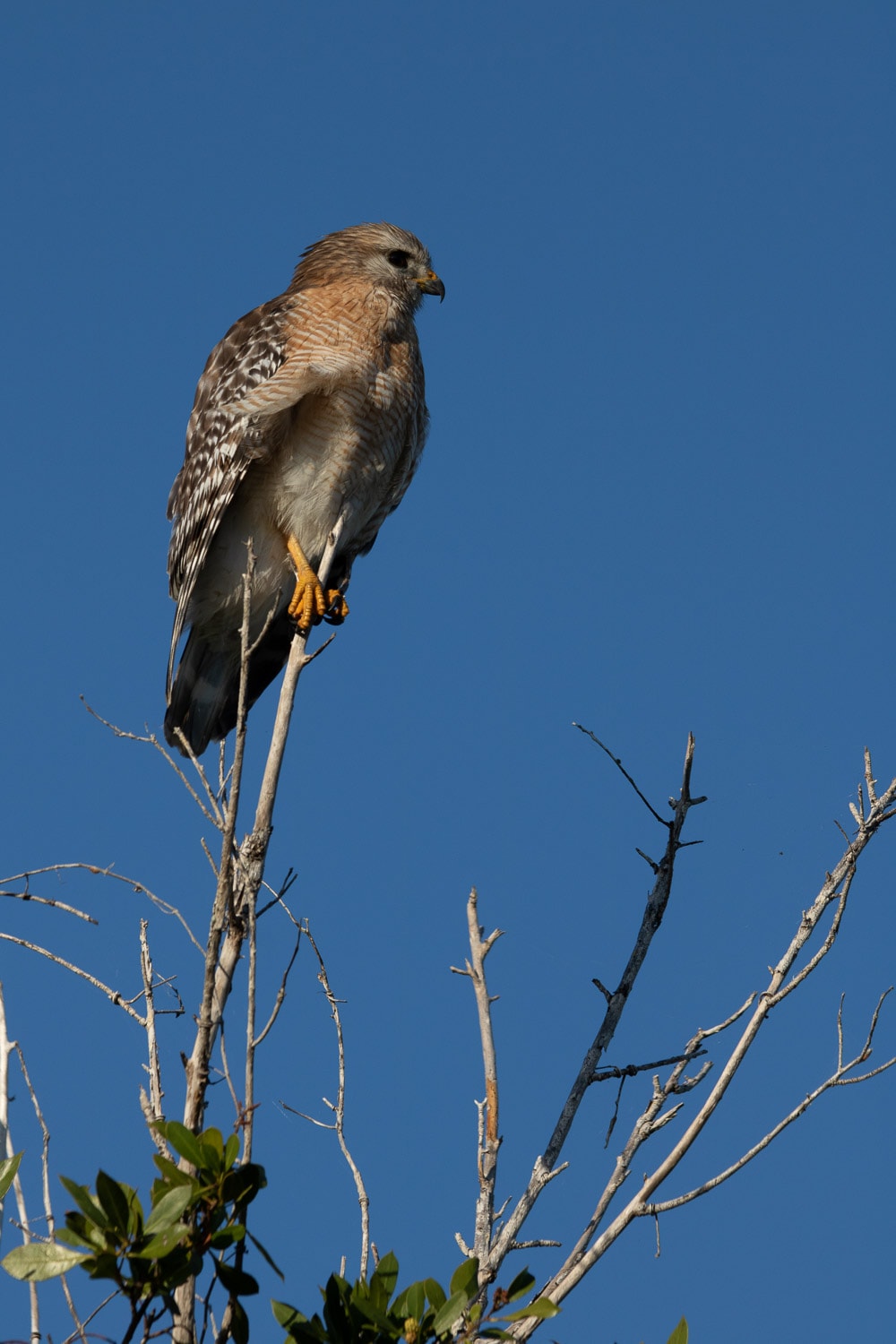
Of the many hawk, harrier and kite species in the Everglades, red-shouldered hawks (Buteo linaetus) are by far the most common.
Once abundant all over the eastern United States, nowadays they’re common throughout the year in only California and the Southeast. Populations in Florida, especially in the Everglades, are exceptionally visible due to the region’s open landscapes.
You’ll find red-shouldered hawks in swamps and marshes, along tree-lined streams, and in lowland forests.
Their hunting strategy consists of watching for prey from a perch, which can be in a forest or in open areas, then swooping down and catching prey with their sharp talons.
Red-shouldered hawks eat a variety of animals. Their diet ranges from small mammals like chipmunks and voles to frogs, toads, crayfish, small birds, big insects, snakes, and occasionally fish.
In the Everglades, watch for hawks in Big Cypress National Preserve, at Pa-hay-okee Overlook, Nine Mile Pond, Eco Pond, and around the Flamingo Marina and Campground.
16. Black Vultures
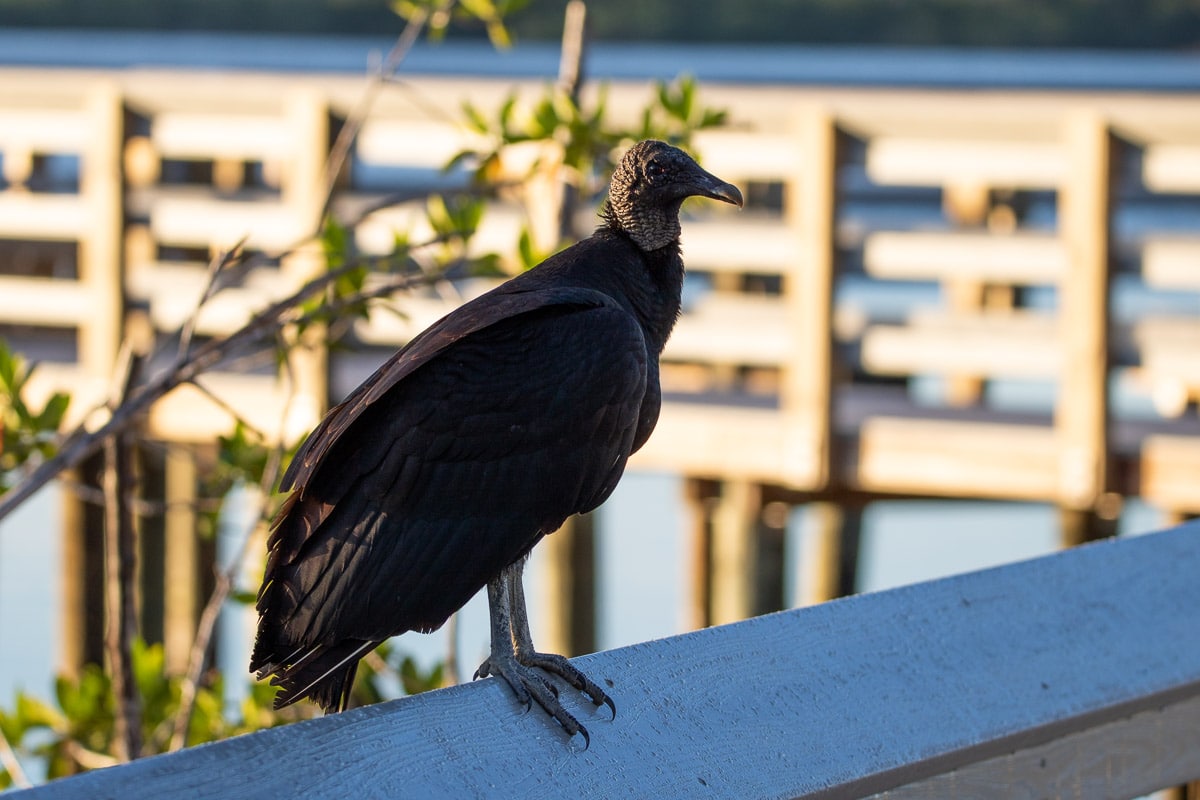
One of two species of vultures that live in the Everglades, black vultures (Coragyps atratus) live only in the Southeast, where they are abundant.
Equipped with large, broad wings, these scavengers are typically seen in flocks, often soaring in circles (very) high in the sky.
From the sky, they look for carrion, which is their primary source of sustenance, while also paying attention to the behavior of other vultures, which they may follow to find food.
Black vultures are easily recognizable by their color. They’re entirely black or dark gray, literally from their bald head to their toes.
17. Turkey Vultures
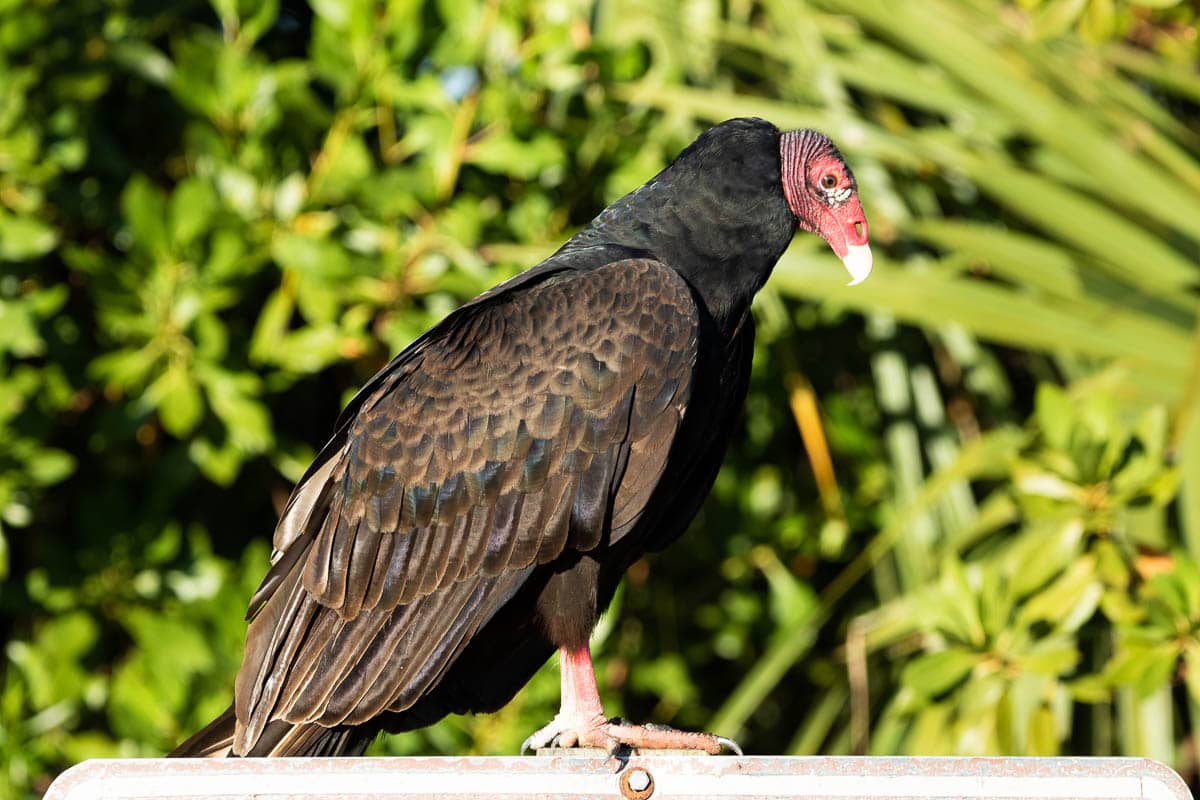
Much more widely distributed than black vultures, turkey vultures (Cathartes aura) are ubiquitous throughout the United States. They’re present year-round in the Everglades, where they feed, breed and nest.
Turkey vulture sightings in the Everglades are all but guaranteed, whether it’s them circling high in the sky or sunbathing in a tree with their wings spread.
These large scavenging birds of the Everglades seek fresh carrion while soaring over open marshlands, grasslands or semi-wooded landscapes. They keep an eye on both the ground and other vultures, which may lead them to a food source.
Turkey vultures are noteworthy because, unlike most other birds, their sense of smell is extremely well-developed. As such, they’re able to locate some fresh carrion by odor alone, often from miles away.
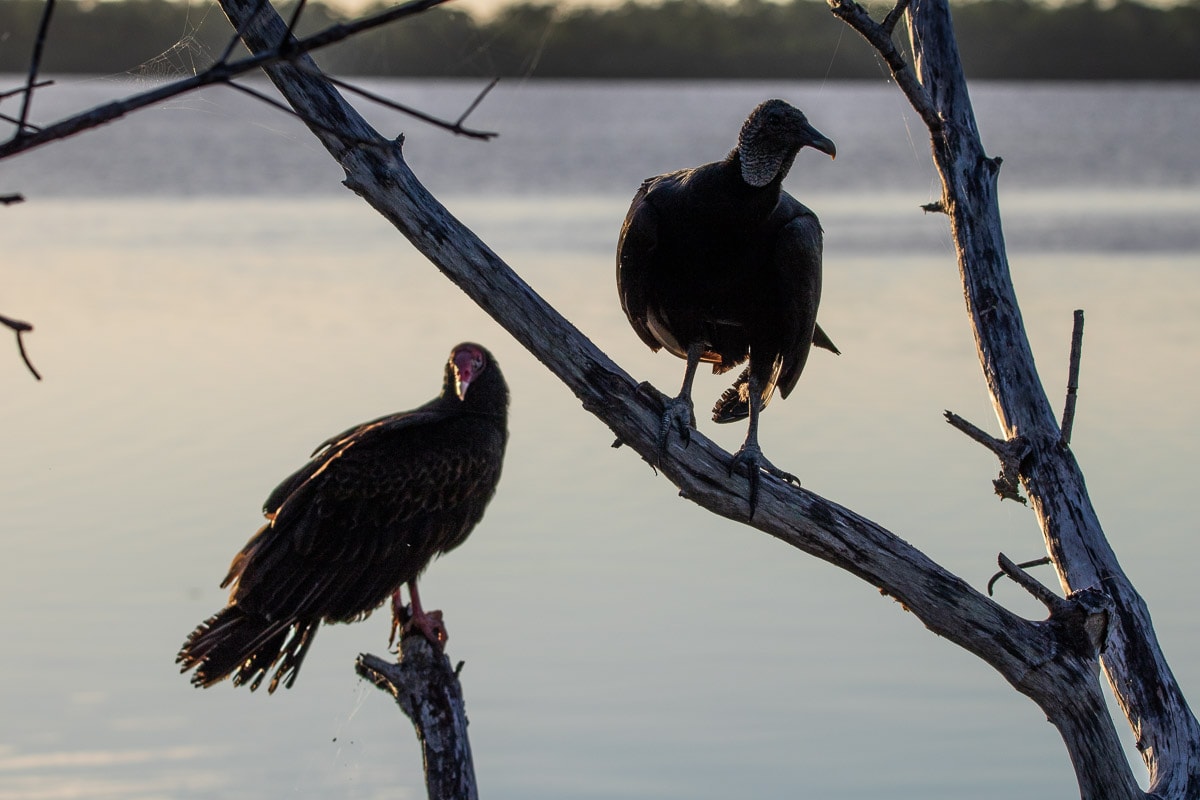
Difference Between Black Vultures and Turkey Vultures
The main distinguishing feature between black vultures and turkey vultures is their head. As their name suggests, turkey vultures have a head that resembles that of a turkey. It’s bald and bright red. Black vultures have a black head.
When you’re looking up at vultures soaring in the sky, you can distinguish between both species by looking at their feathers.
Black vultures have all-black wings with light-colored tips, and their tail is short and fan-shaped.
Turkey vultures, on the other hand, have wings that are only black at the “arms” and all underwing flight feathers have a much lighter color. The tail of turkey vultures is rather long and stubby.
Learn more about the differences between black vultures and turkey vultures here on the Avian Report.
More Birds of Prey of the Everglades
- Bald eagles
- Swallow-tailed kites
- Snail kites
- Short-tailed hawks
- Red-tailed hawks
- Crested caracaras
- Great horned owls
- Barn owls
Water Birds of the Everglades
Although wading birds are technically water birds, I did want to put them in their own category simply because how important and distinctive they are to the Everglades.
In this separate category of Everglades water birds, we’ll look at some of the other aquatic bird species that call the greater Everglades National Park region home. This includes birds that can swim and hunt in water, live in aquatic environments and/or forage along waterlines.
18. Anhingas
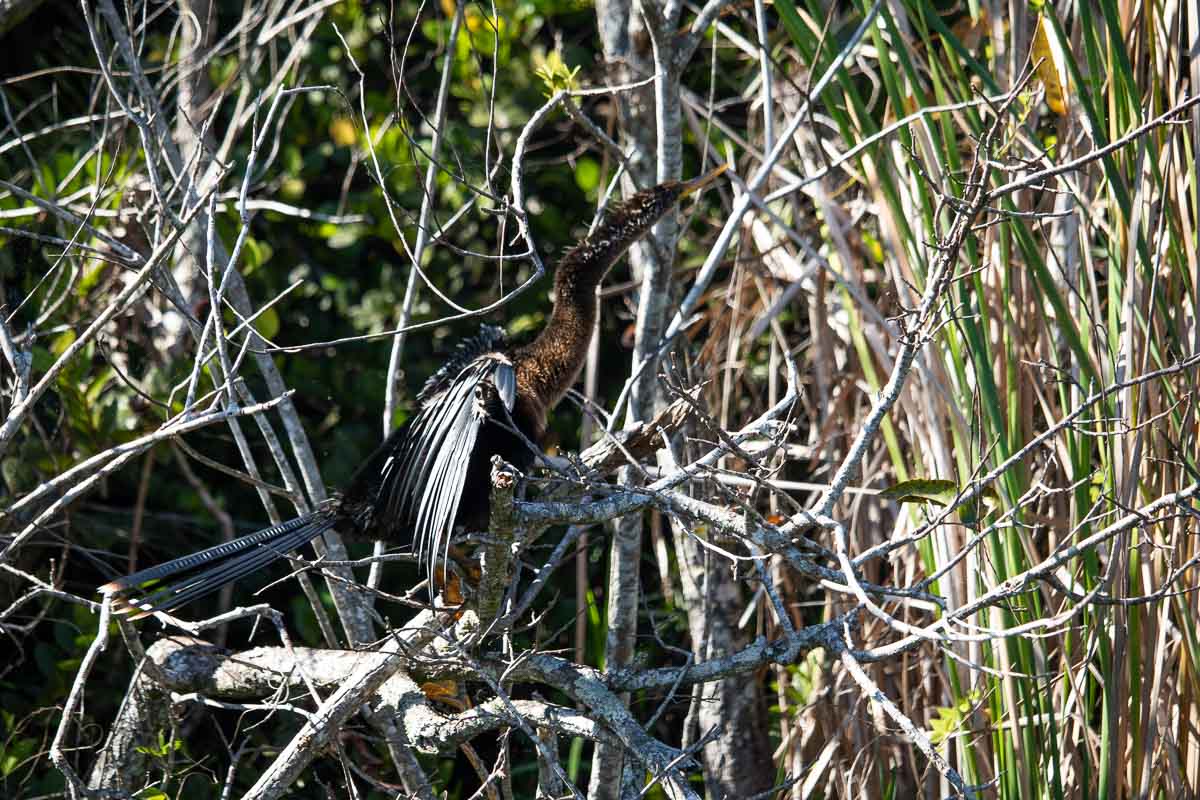
One of the most iconic birds of the Everglades, anhingas (Anhinga anhinga) are found near quiet and slow-moving waters.
In the Everglades, look for them in freshwater marshes with trees, in cypress swamps, along the mangrove-lined coastline, and at wooded lakes and ponds.
The best places to see anhingas in Everglades National Park are Shark Valley and the aptly named Anhinga Trail at Royal Palm. You might also see them in the cypress swamps of Big Cypress National preserve.
When perched on a tree, anhingas look like cormorants—you can often see them sunbathing with their wings outstretched. What separates them from other birds in the Everglades, however, is their peculiar swimming style.
These birds have the extraordinary capacity to change their buoyancy in water. They sometimes swim semi-submerged with only their head and neck above the water, which has earned them the nickname of ‘snakebird.’
Anhingas feed mostly on fish, which they impale by a sudden thrust of their long, sharp and pointy bill. They then toss the fish into the air, catching and swallowing them headfirst.
19. Double-crested Cormorants
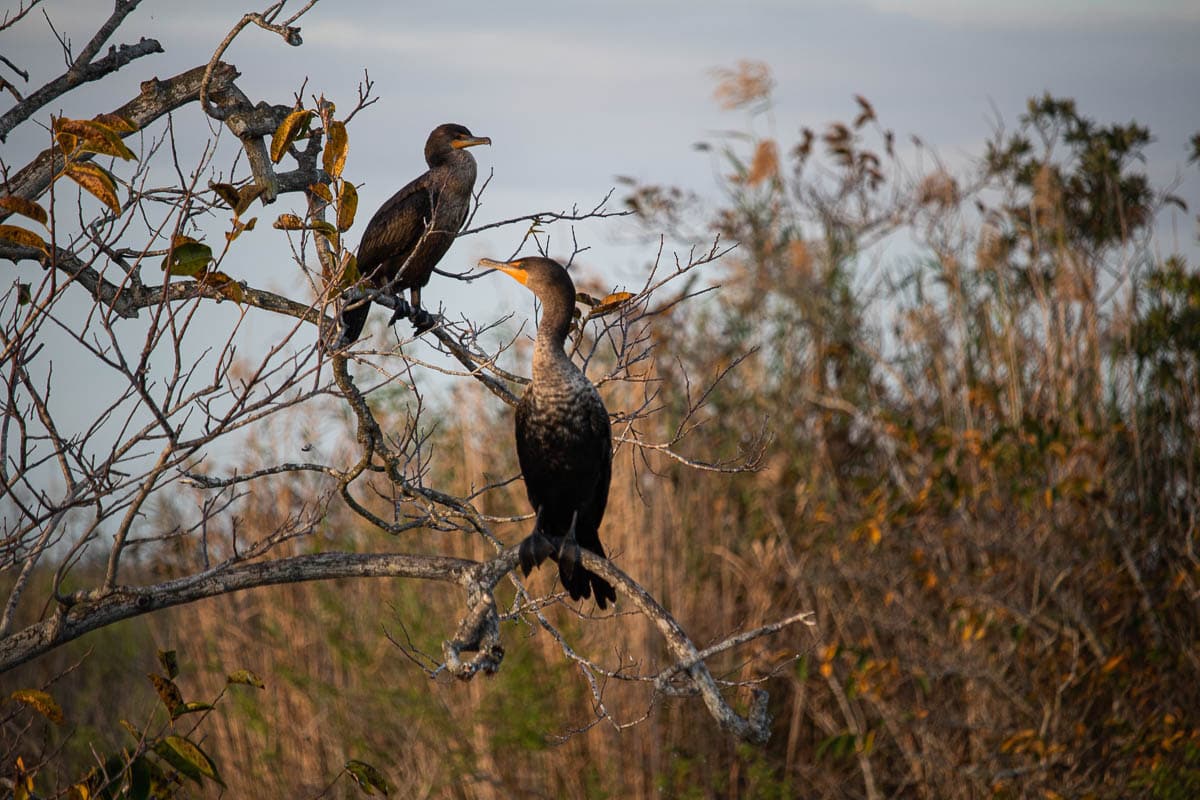
Present year-round in large numbers in the Everglades, double-crested cormorants (Nannopterum auritum) are at home in virtually all aquatic habitats.
You’ll find them around freshwater ponds, canals, streams and marshes, as well as in saltwater mangroves and on islands.
The double-crested cormorant is the only common cormorant species in the Everglades. Characterized by a dark plumage, long body, yellow-orange face, and prehistoric-looking bill, these heavy-boned water birds are excellent divers.
They hunt fish, shrimp, crabs, crayfish, frogs, and mollusks by swimming underwater, propelled by their strong legs and sometimes their wings.
You can often see them standing in the sun with their wings spread out to dry.
In the Everglades, look for double-crested cormorants in Big Cypress National Preserve, along the Anhinga Trail, at Nine Mile Pond, West Lake and Eco Pond, and in the Flamingo area and Florida Bay.
20. Purple Gallinules
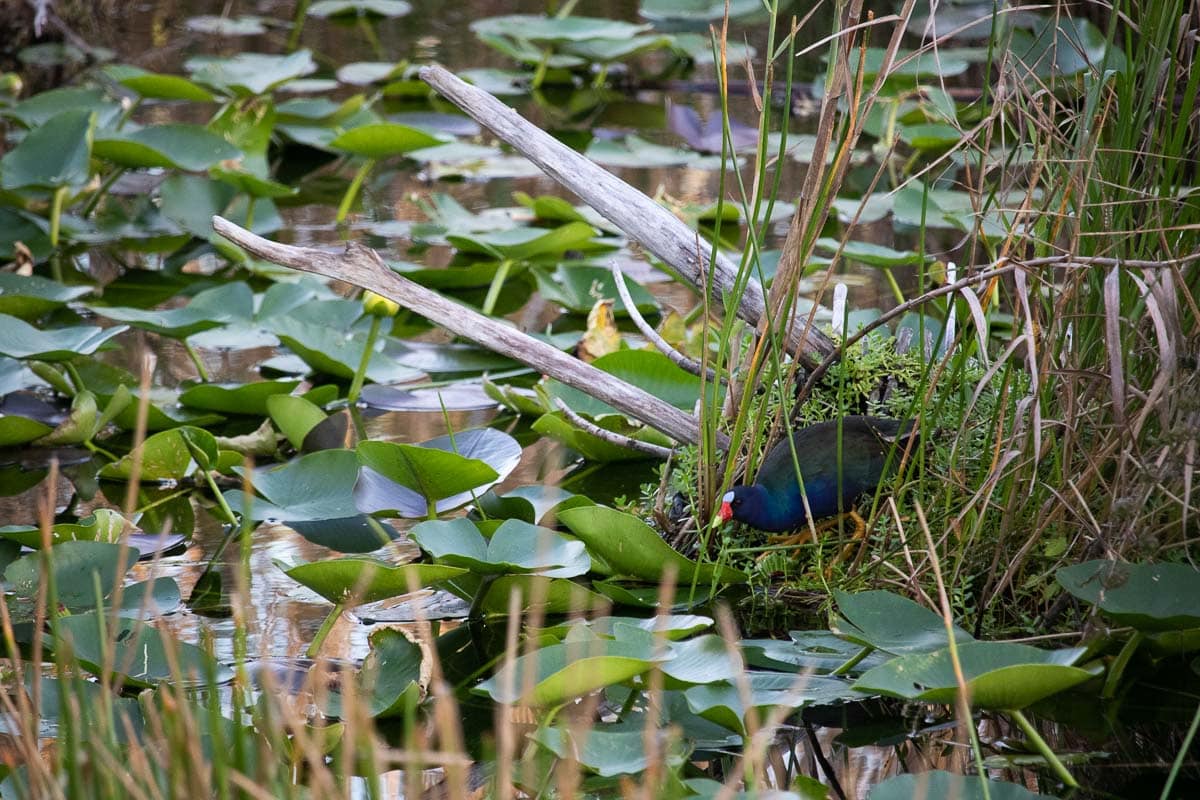
A member of the rails, gallinules and coots family, the purple gallinule (Porphyrio martinicus) is a vibrantly colored marsh bird.
I personally think that, although they’re rather small and low-profile, these are one of the most beautiful birds you can see in the Everglades.
Purple gallinules are easy to recognize thanks to their blue-and-purple body, green wings and conical yellow-red beak. These chicken-sized birds also have very long yellow-colored legs and toes.
You can see purple gallinules all year round in the freshwater habitats of the Everglades. They’re commonly seen along open shorelines, in muddy marshlands, along ponds, and on water plants like lilies.
Their diet consists of both plants and animals, ranging from fruits, seeds, and leaves to insects, spiders, worms, snails, and small fish.
21. Terns
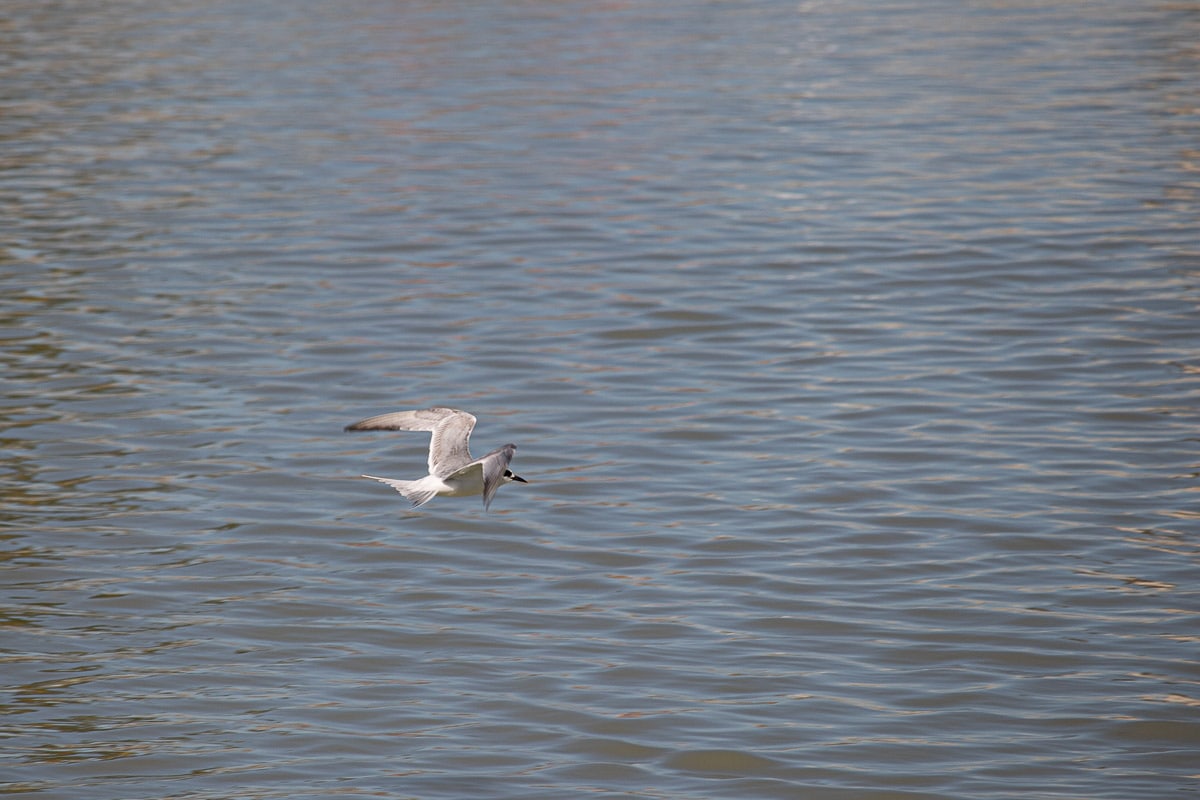
Similar to to gulls and skimmers, terns are common seabirds along the coast of south Florida.
They’re small, slender and lightweight birds with forked tails, long bills and narrow wings. Almost all terns in the Everglades have black, white and gray colors, the patterns of which are species-specific.
Many terns feed by hovering above the water and then swiftly diving straight down, plunging headfirst into the water, catching fish with their bill. Sometimes, they may also skim the water or catch insects in flight.
Several species of terns live in the Everglades, particularly in the Flamingo area and Florida Bay. Tern species you might see during your visit include Caspian terns, royal terns, sandwich terns, Forster’s terns and least terns.
22. Brown Pelicans
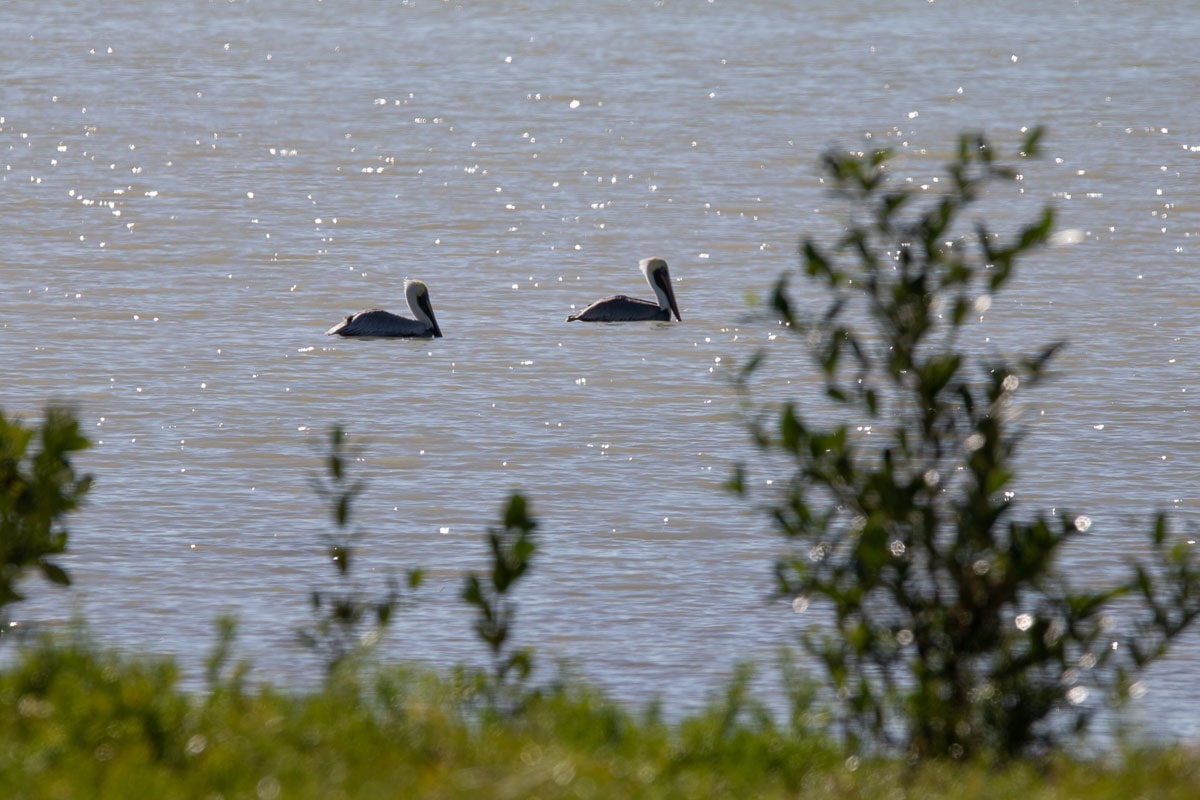
A common coastal bird on all three major coasts of the United States—East Coast, Gulf Coast and West Coast—brown pelicans (Pelecanus occidentalis) thrive in the shallow fish-rich waters of Florida Bay. They’re present in Everglades National Park throughout the entire year.
You can often see groups of brown pelicans flying in formation, which is usually in single file, just above the water’s surface. When flying, they typically act in unison, flapping and gliding synchronically.
Brown pelicans also regularly hang out on sandbars or in open water. They almost exclusively eat fish, which they hunt by spectacularly diving headfirst from the air into the water.
23. American White Pelicans
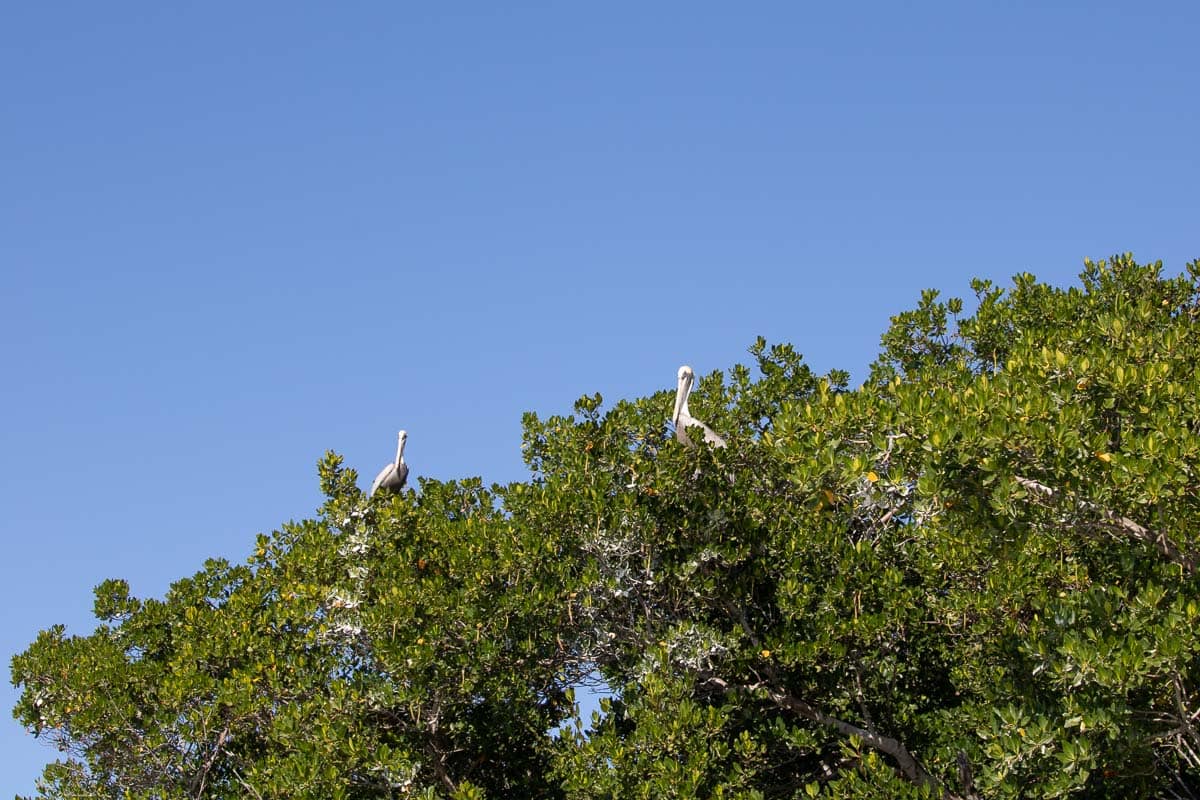
Closely related to the brown pelican, American white pelicans (Pelecanus erythrorhynchos) live throughout North America.
They usually breed far up north and in the heart of the continent, while migrating to warmer southerly locales in winter, including south Florida and the Everglades.
With a wingspan of up to 9 feet, American white pelicans are one of the largest North American birds. They’re significantly larger than their brown cousins and exhibit very different behaviors. For instance, they occur far inland and don’t feed by diving into the water from the sky.
Instead, American white pelicans forage by swimming on the water’s surface, putting their big bills into the water, and simply scooping up fish in their bill pouch.
In the Everglades, however, you can often see brown and American white pelicans side by side.
Even though they have different feeding habits, both pelicans do seek out similar environments. Look for American white pelicans, as well as brown pelicans, near the Flamingo Marina and, especially, in Florida Bay.
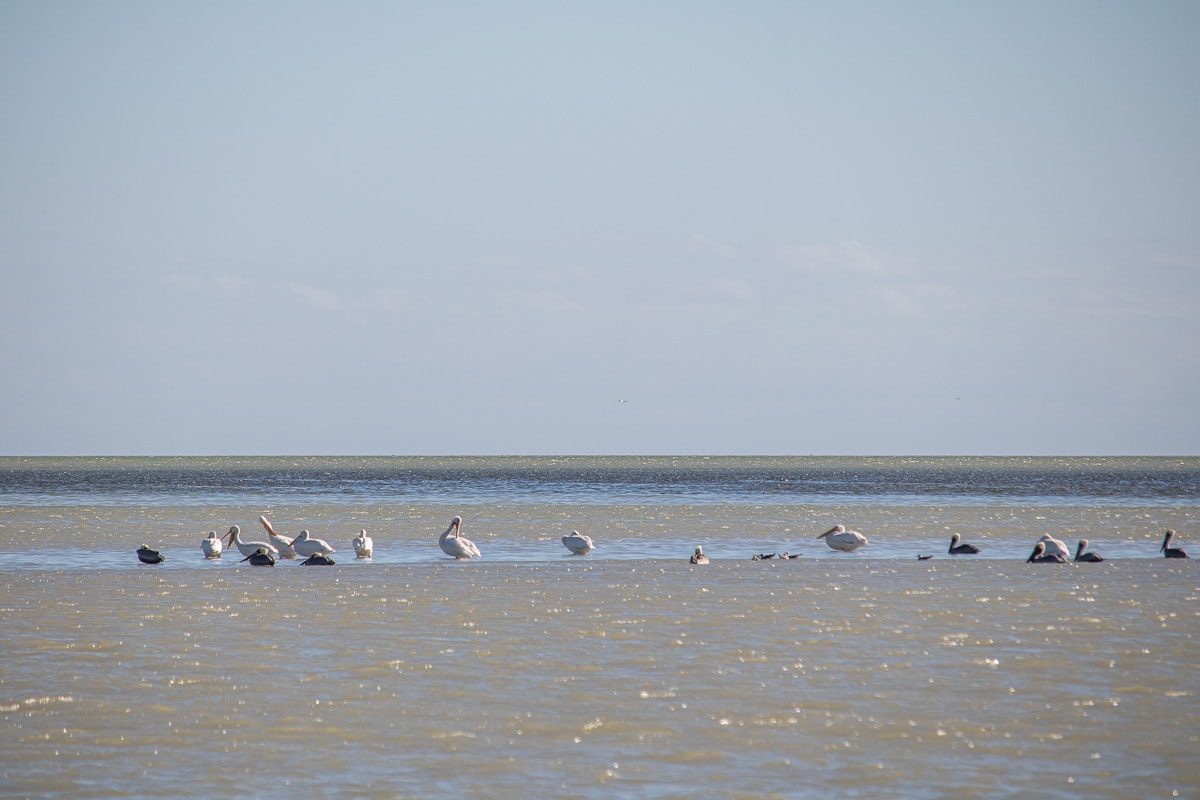
Difference Between Brown Pelicans and American White Pelicans
As their respective names suggest, the biggest difference between brown pelicans and American white pelicans is their color.
Brown pelicans have a dark-colored plumage, which is usually gray-brown. They have a yellowish head, dark bill, and white neck. Their legs are also dark, almost black.
American white pelicans, on the other hand, are almost entirely white. They do have black flight feathers, though, which are visible only when they’re in flight. Their legs and massive bill have a yellow-orange color.
Additionally, adult American white pelicans grow a yellow horn-like plate on their upper bill when breeding.
Besides their distinct colors, both species also differ in terms of size. Brown pelicans are much smaller than American white pelicans.
More Water Birds of the Everglades
- Ducks and geese
- American coots
- Common moorhens
- Limpkins
- Sandhill cranes
- Common loons
- Plovers, sandpipers and gulls
Other Birds of the Everglades
Besides wading and water birds, and birds of prey, there are literally hundreds more birds in the Everglades. This category touches on the immense variety of other Everglades birds, from mockingbirds and woodpeckers to grackles and kingbirds.
24. Mockingbirds, Catbirds and Thrashers
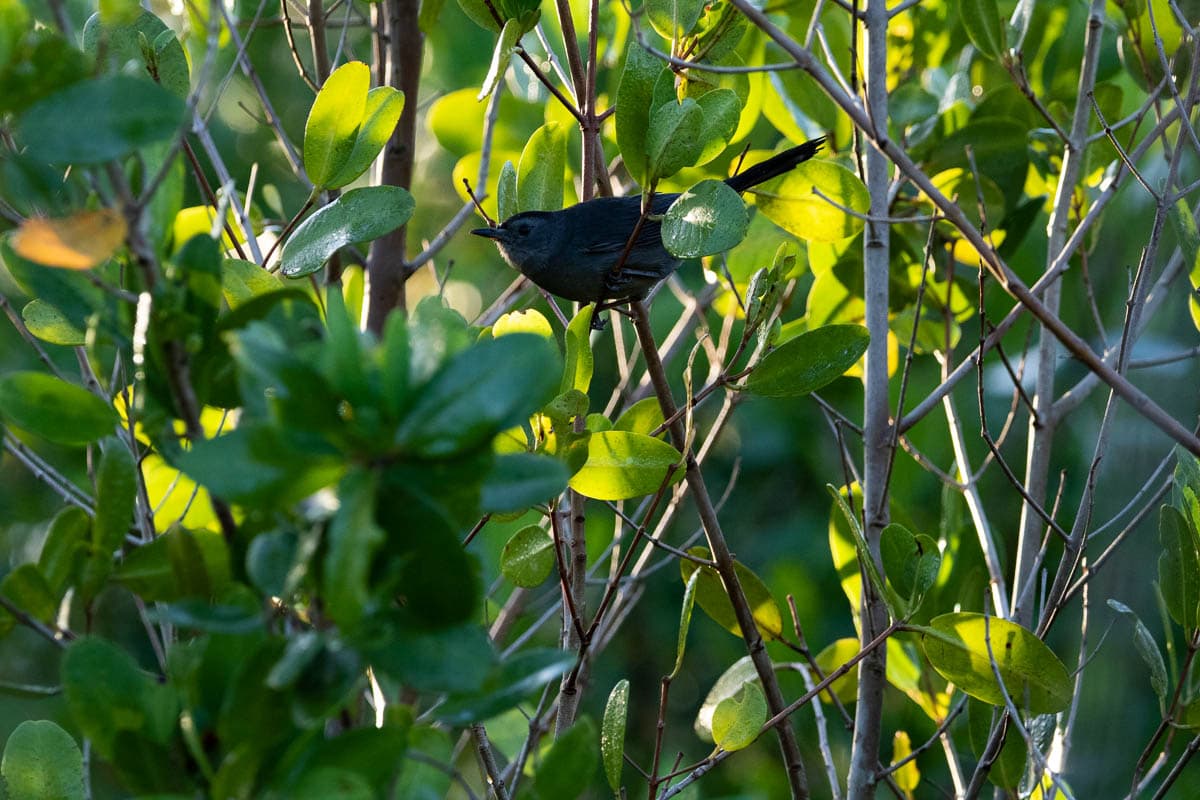
Several species of mockingbirds and thrashers call the Everglades home. Known for their beautiful, melodious and elaborate songs, this category of songbirds includes the Bahama mockingbird, northern mockingbird, gray catbird, and brown thrasher.
Feeding mainly on berries and insects, these birds are often found in areas with both open grassland and forest.
25. Blackbirds and Orioles
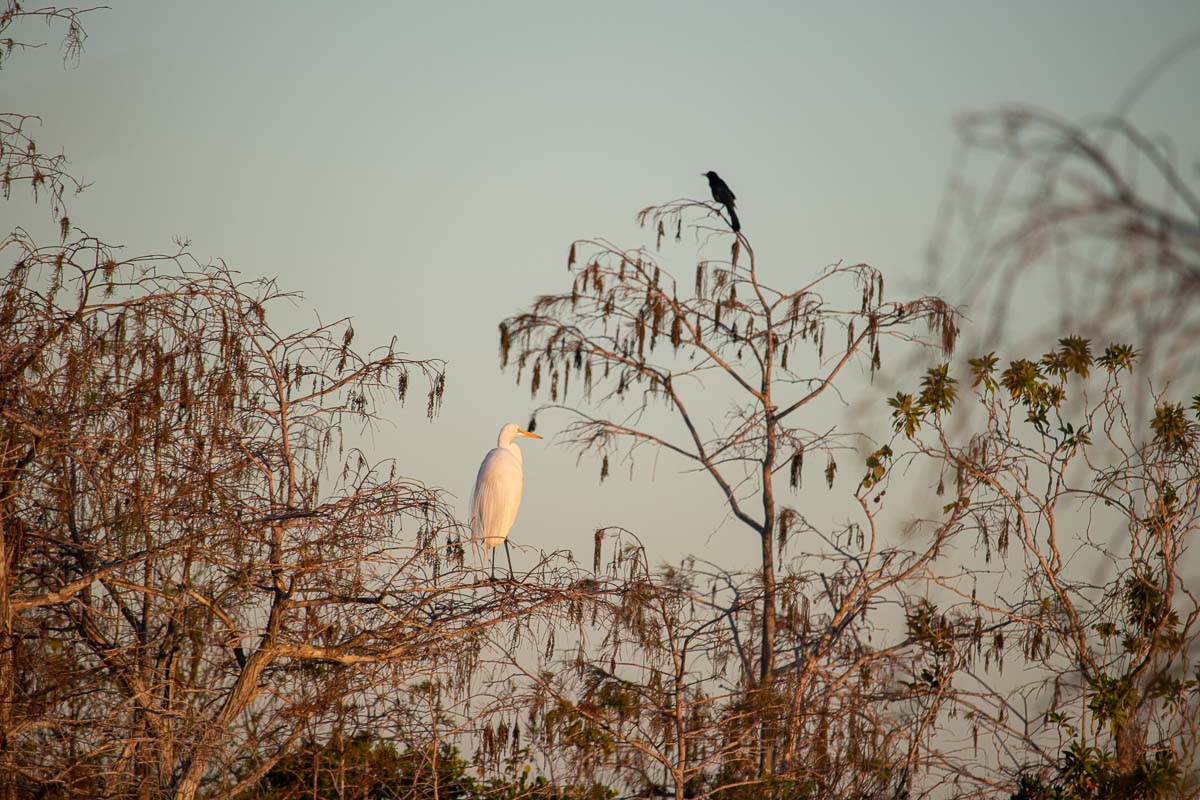
A colorful and varied family of birds, there are more than ten blackbird and oriole species in the Everglades. These birds typically prefer wide-open areas, whether it’s sawgrass marshes, coastal prairie, or large bodies of water.
Look for them all along the Main Park Road, especially in places like the Pa-hay-okee Overlook, around Mahogany Hammock, and in the Flamingo area.
Watch for Baltimore orioles, common and boat-tailed grackles, eastern meadowlarks and red-winged blackbirds.
26. Woodpeckers
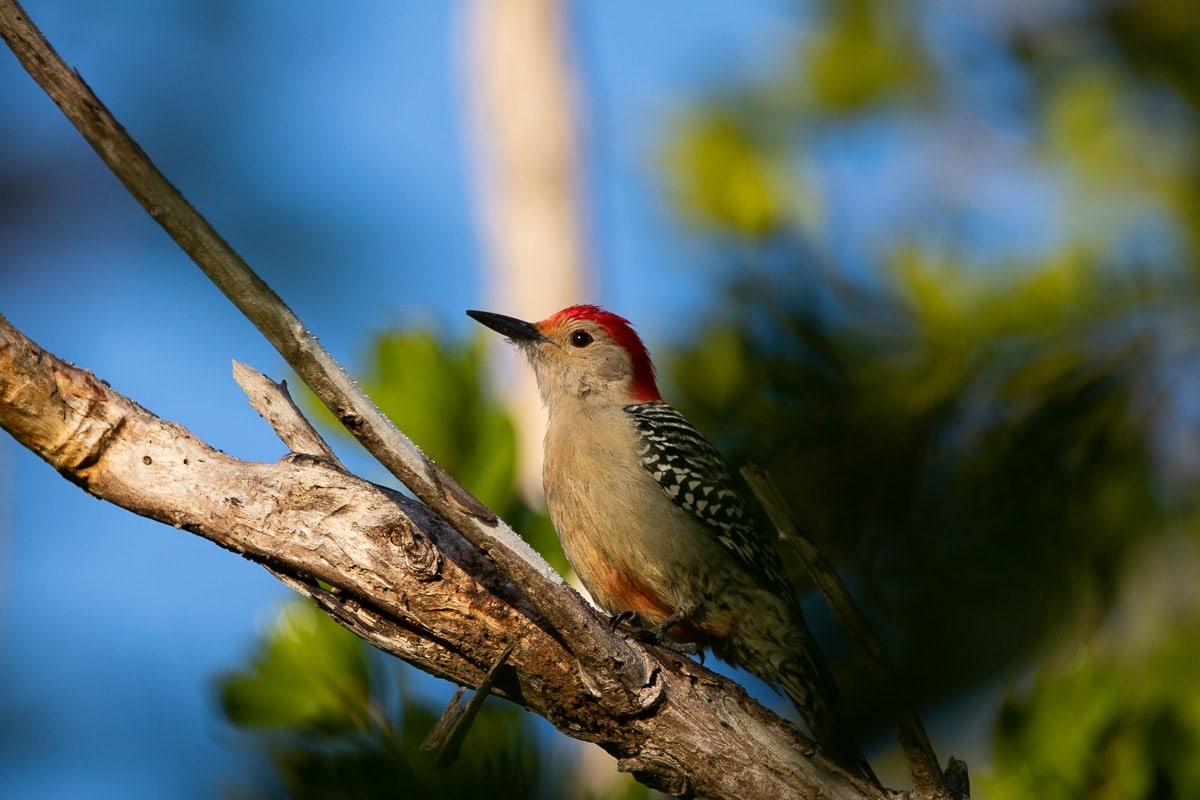
The Everglades is more than expansive wetlands. There are cypress swamps, hardwood hammocks, and pine forests, too. All these wooded environments provide the perfect habitat for half a dozen species of woodpeckers.
Common Everglades woodpeckers are northern flickers, pileated woodpeckers and red-bellied woodpeckers. Yellow-bellied sapsuckers, downy woodpeckers and hairy woodpeckers, on the other hand, are also present but less often seen.
27. Flycatchers and Kingbirds
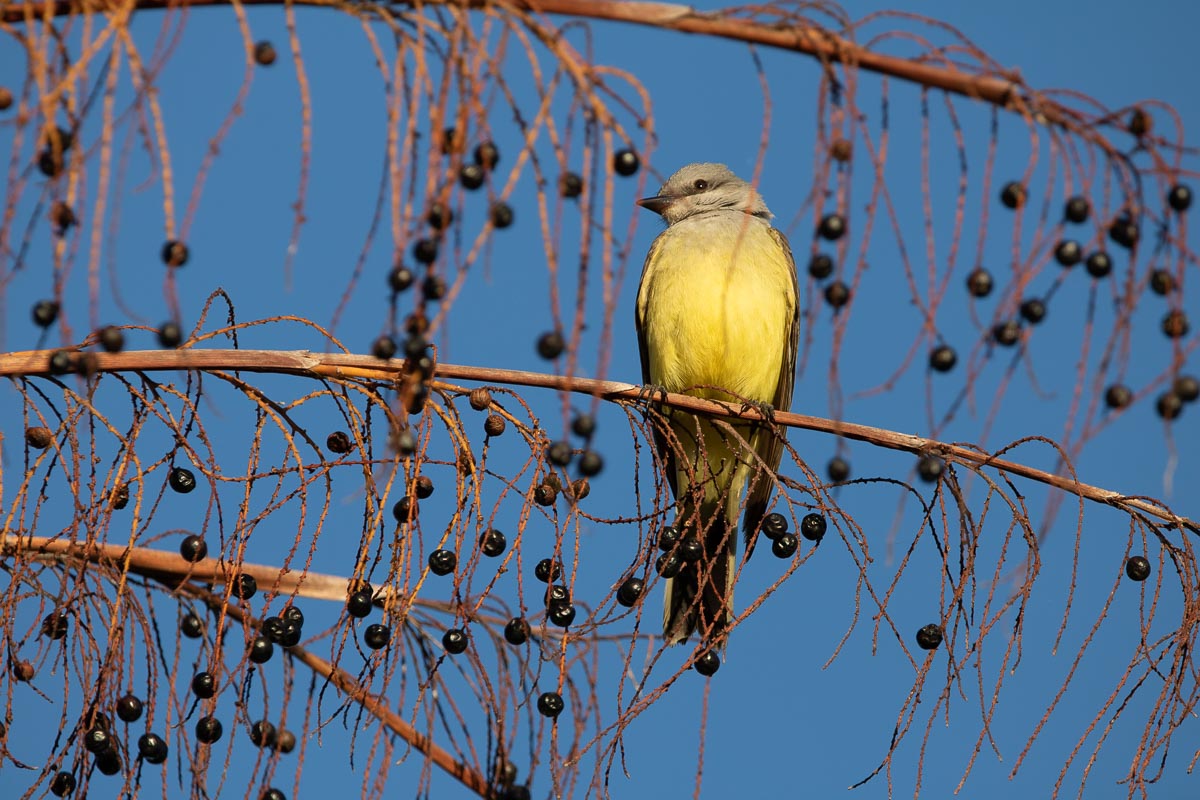
With some exceptions, notably the eastern kingbirds, gray kingbirds and great-crested flycatchers, most flycatchers and kingbirds are present in the Everglades only seasonally. Many overwinter in this warm environment winter, while spending their summers somewhere else.
Other members of this family to look for, especially in fall and winter, include eastern phoebes, western kingbirds, vermillion flycatchers, and brown-crested flycatchers.
As their name implies, these birds feed primarily on insects. They look for prey from a perch, which could be a tree but also a building, tower, pole, or fence. They then fly out to catch their meal, such as flies, moths, beetles, grasshoppers, bees, wasps, and caterpillars.
You’ll find flycatchers and kingbirds in semi-open country, near woodland edges, along streams, and around ponds and lakes.
28. Kingfishers
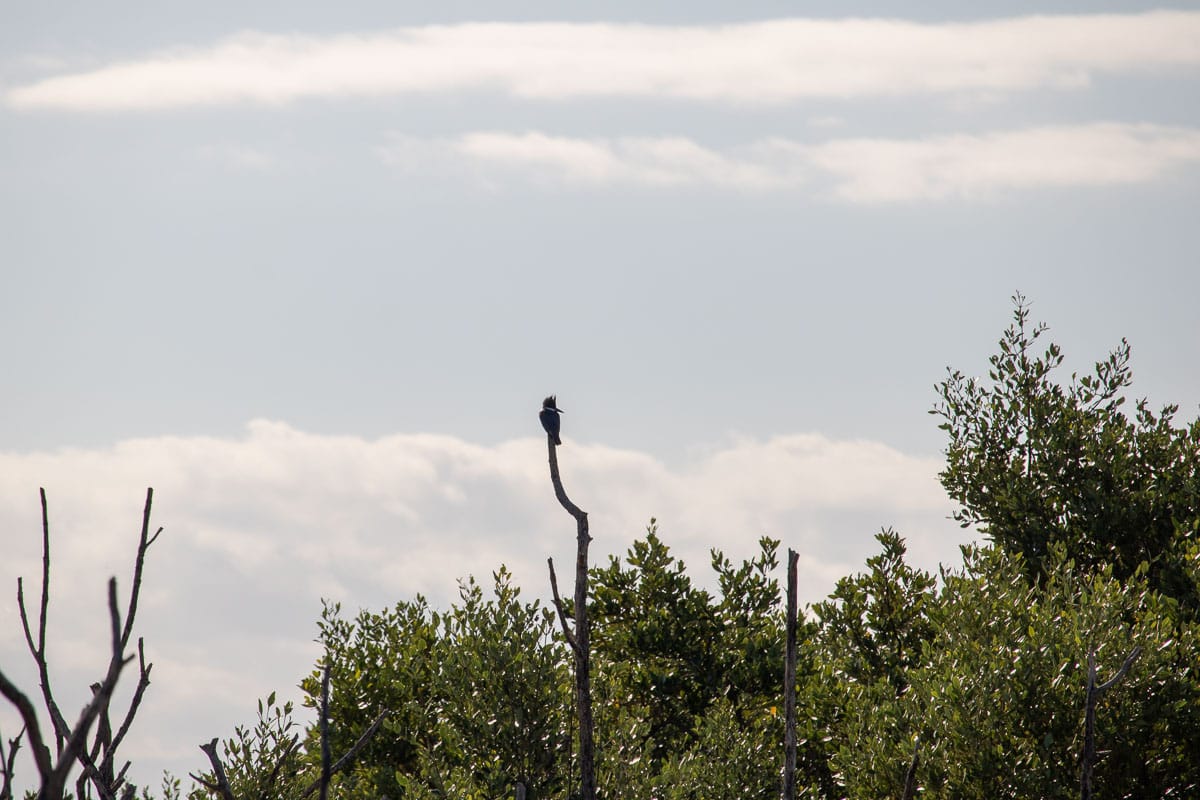
One species of kingfisher calls the Everglades home, the beautiful belted kingfisher (Megaceryle alcyon).
An abundant waterside bird throughout North America, from northern Alaska and Canada to California, the Southwest and south Florida, belted kingfishers thrive in virtually every aquatic environment.
These compact little birds have a typical large head with a gray-blue “mohawk” and a big daggerlike bill. Their plumage is alternatingly gray-blue and white, while the females also have a chestnut-colored breast stripe and sides.
Belted kingfishers live near streams, rivers, ponds, lakes, bays, beaches, estuaries, coasts,… basically anywhere that has fish-rich water. They nest in banks.
You’ll often see them perched by themselves on the edge of a body of water, scanning the water for small fish.
When they’ve located prey, they plunge headfirst into the water, catching it with their bill. Belted kingfishers sometimes also hover above the water before diving in.
Many More Birds of the Everglades
- Cuckoos
- Hummingbirds
- Pigeons and doves
- Vireos
- Swallows
- Sparrows
- Buntings
- Warblers
- Wrens
More About Everglades National Park
- Park Website
- Travel Guide
- Topographic Map
- Where to See Wildlife in Everglades National Park
- Where to See Alligators and Crocodiles in the Everglades
- Best Everglades Bike Trails
- Top Sights on the Everglades Main Park Road
- Top Things to Do in Flamingo, Everglades National Park
- Top Things to Do in Shark Valley, Everglades National Park
- Accommodation
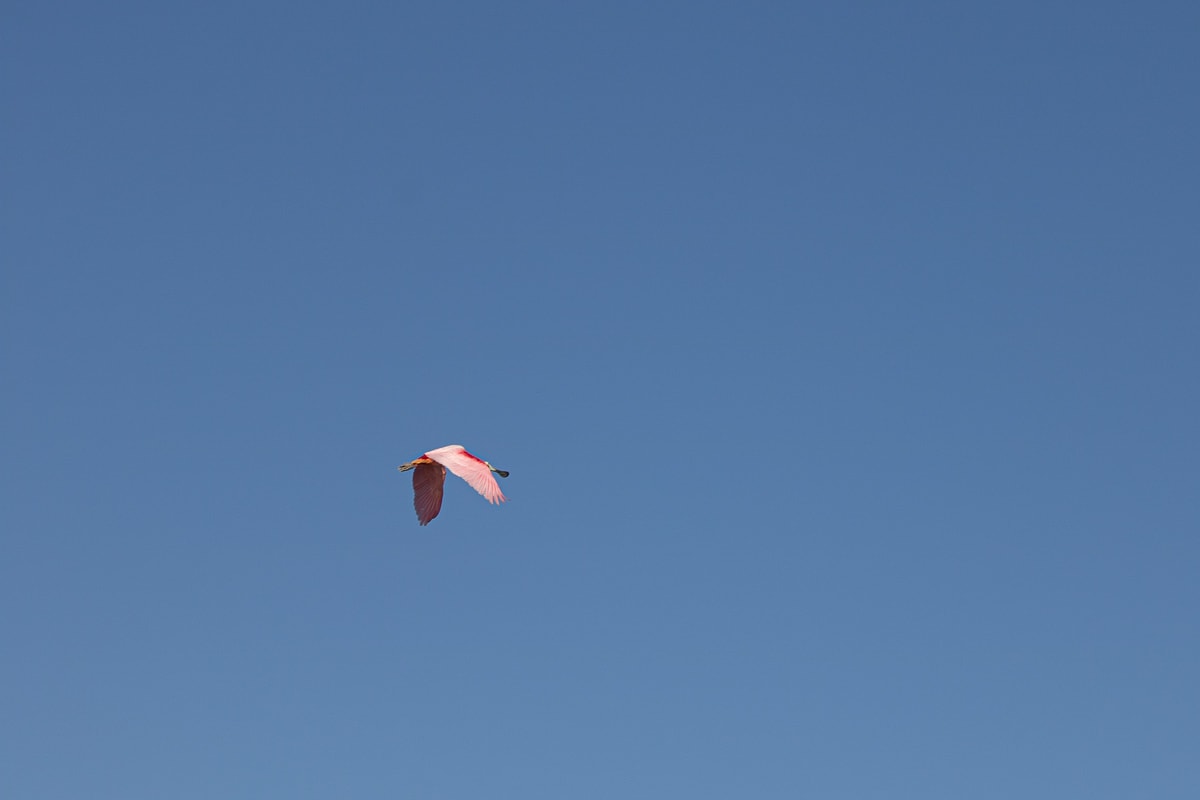
13 Best Places to See Birds in the Everglades
If you’re wondering which are the best places to see birds in the Everglades, the following checklist will cover all your bases.
The first list features the best bird viewing areas along the Main Park Road in Everglades National Park, ranked from north to south.
This road runs through the heart of the national park and past basically all of its different habitats, including hardwood hammocks, sawgrass marshes, cypress swamps, mangrove forests, coastal beaches and estuaries.
The second list contains the top spots to watch birds on the Tamiami Trail along the northern boundary of Everglades National Park and through Big Cypress National Preserve, just west of Miami. Although significantly shorter, this list’s places are among the very best places for Everglades bird watching.
You’ll also find some of the most common birds you can see at each location. Note, though, that this is a very limited overview of possible Everglades bird sightings. Many of these places are home to countless more bird species than those listed.
This overview is based on the National Park Service’s recommended Everglades bird watching locations, as well as one my own experience looking for birds in the Everglades.
You can see Everglades National Park’s official bird checklist here. For bird species that call Big Cypress National Preserve home, check out the park’s checklist here.
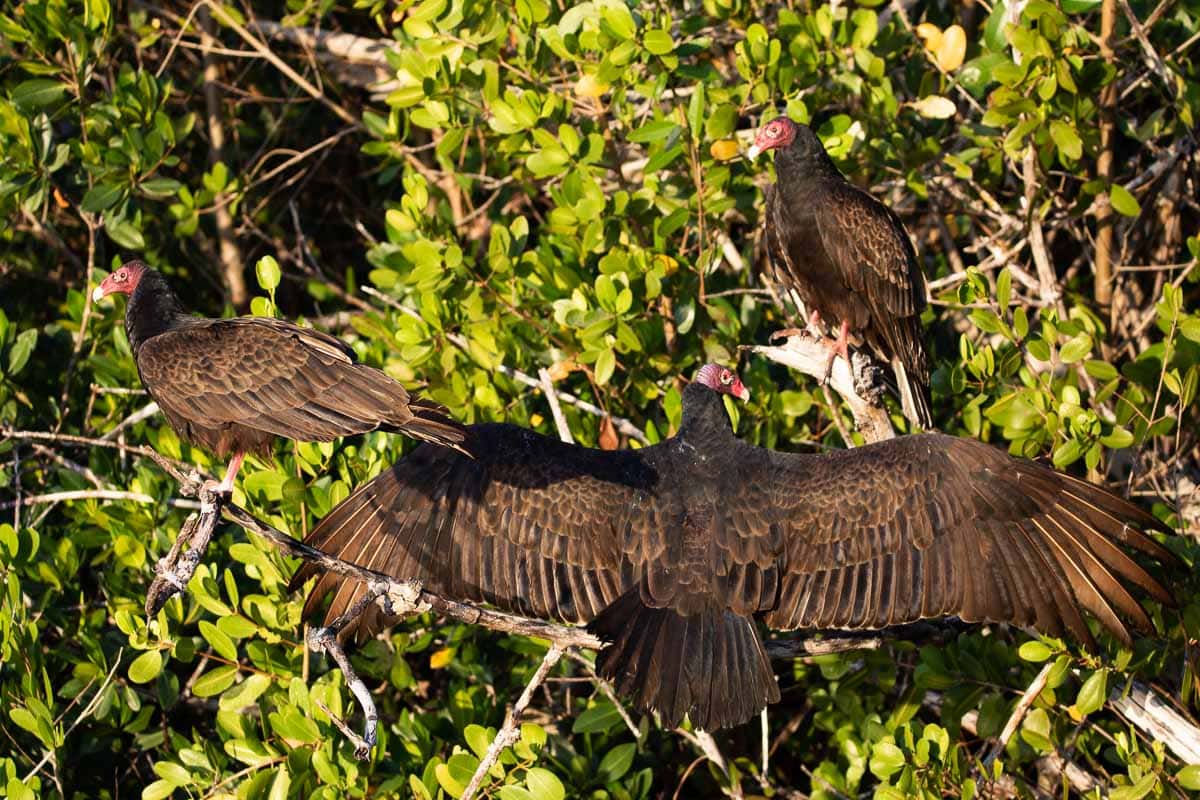
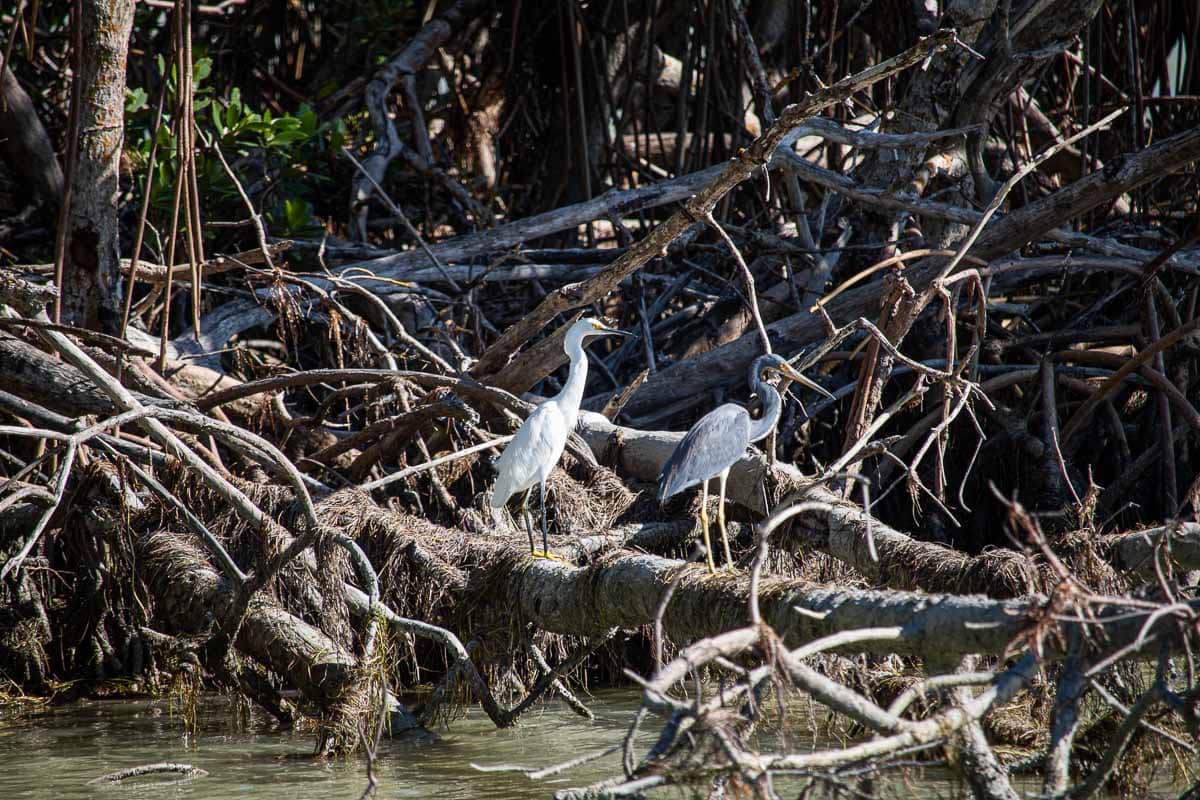
Best Places to See Everglades Birds on the Main Park Road
- Anhinga Trail: wading birds, anhingas, cormorants, purple gallinules
- Pa-hay-okee Overlook: owls and hawks, wading birds, woodpeckers blackbirds and orioles
- Mahogany Hammock Area: Cape Sable seaside sparrows, bald eagles and owls, woodpeckers, warblers, wrens, flycatchers and kingbirds, hummingbirds, some wading birds
- Paurotis Pond: wading birds like roseate spoonbills and (seasonal) wood storks, vultures and other birds of prey
- Nine Mile Pond: red-shouldered hawks, snail kites, cormorants, wading birds like roseate spoonbills and egrets, limpkins, white-crowned pigeons
- West Lake Boardwalk: black and turkey vultures, woodpeckers, cormorants, mockingbirds, catbirds, herons, egrets
- Snake Bight Trail: mangrove cuckoos, shorebirds and wading birds like herons, egrets, and the occasional flamingo
- Mrazek Pond: ducks and wading birds
- Eco Pond: red-shouldered hawks, osprey, anhingas, American coots, cormorants, white-crowned pigeons, warblers, buntings
- Flamingo Marina: red-shouldered hawks, osprey, black and turkey vultures, terns, cormorants, ducks and geese, wading birds like herons, roseate spoonbills, ibis, and egrets
- Florida Bay: osprey, terns, brown and white pelicans, cormorants, roseate spoonbills, egrets and herons, ibis, numerous shorebirds
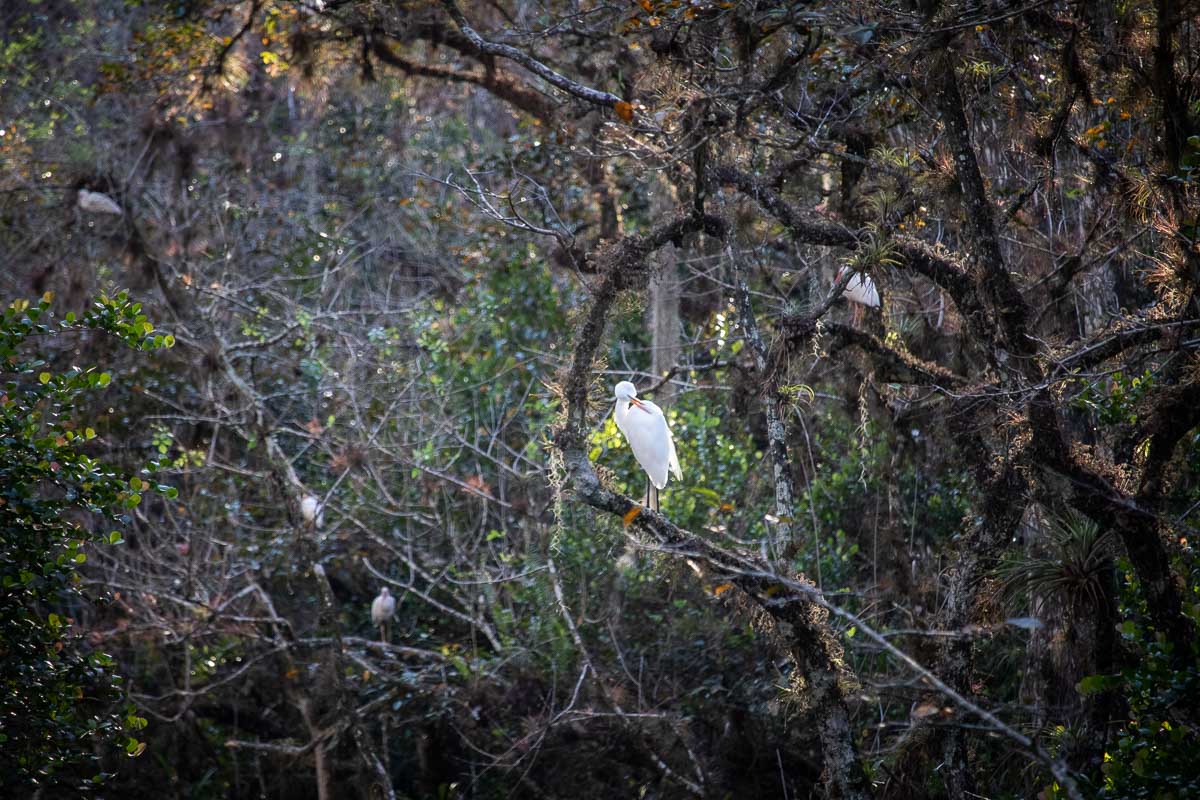
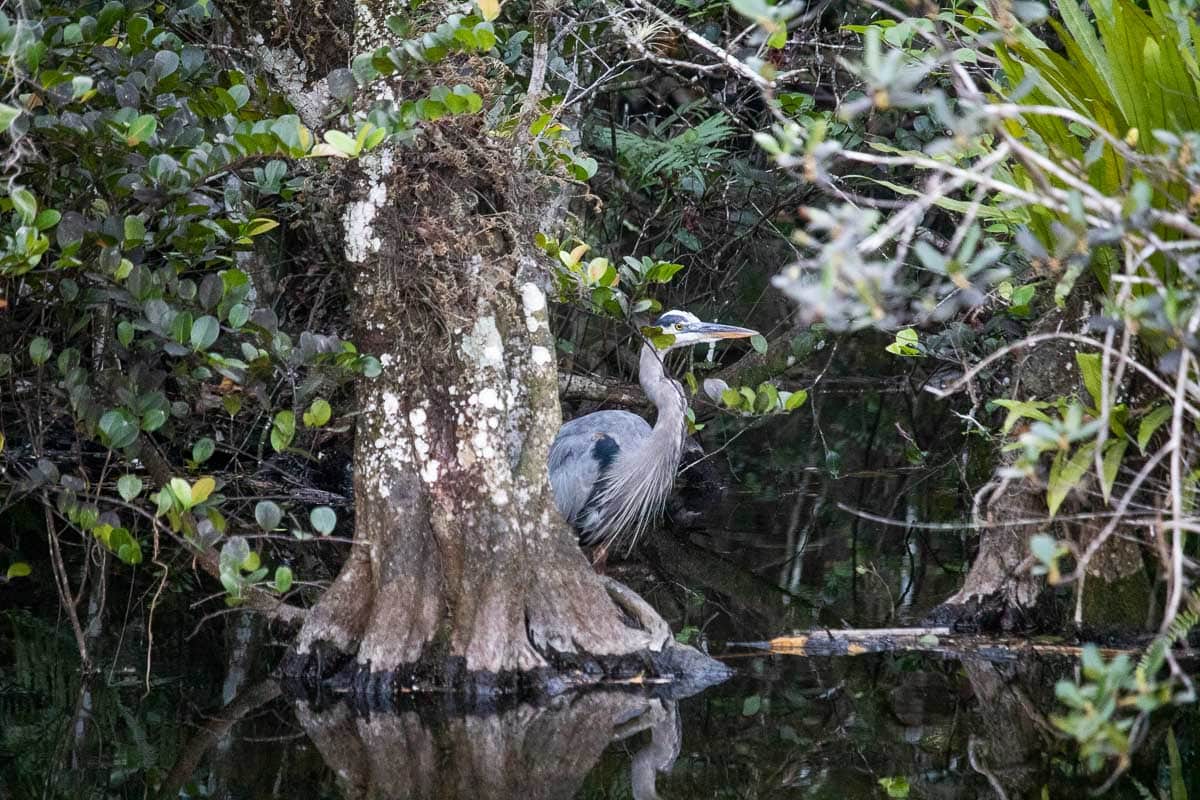
Best Places to See Everglades Birds on the Tamiami Trail
- Shark Valley: anhingas, limpkins, snail kites, wading birds like wood storks, herons, and egrets
- Big Cypress National Preserve: anhingas, red-shouldered hawks, mockingbirds, warblers, woodpeckers, and 16 different species of wading birds, including egrets, herons, and ibis
Have You Ever Been Bird Watching in Everglades National Park or Big Cypress National Preserve? Which Everglades Birds Did You See? Share Your National Parks Experience Below!
More Wildlife Viewing in the National Parks
- Where to See Alligators and Crocodiles in the Everglades
- Where to See Grizzly Bears in Glacier National Park
- Where to See Mountain Goats in Glacier National Park
- Where to See Bison in Yellowstone National Park
- Where to See Black and Grizzly Bears in Yellowstone National Park
- Where to See Moose in Grand Teton National Park
- Where to See Black Bears in Shenandoah National Park
